In SEO, backlinks are a lot like votes in elections. By casting your vote (aka linking out to another site), you’re showing that you trust the candidate (another site) and consider their campaign (their content) reliable.
If you want to go deeper into what backlinks are, check out our recent guide on external links and how to use them to boost your SEO.
In government, the election commission counts the number of votes for each candidate, and the candidate with the voting majority wins. In SEO, search bots consider not only the number of votes (backlinks) but also their quality. The overwhelming majority of spoils go to the sites with the highest quality backlinks.
In this article, we’ll uncover three ways to find links to your website so you can analyze their quality and your chances of conquering the SERP.
But first, let’s clear up the terminology to make sure we’re all on the same page.
This post contains different terms that mean the same thing but are used by three different tools that we analyze: Google Search Console, Bing Webmaster Tools, and SE Ranking. We separated these terms into thematic blocks:
- External link, incoming link, backlink: link from another website to your website.
- Internal link: link from one page to another within the same domain.
- Linking URL, linking page, referring page: another URL or page that links out to your website.
- Linking site, referring domain, source domain: another website that links out to your website.
- Linked page, target page, target URL: page on your website that another website links out to.
- Linking text, link text, anchor text: text used in the backlink anchor.
Please note that the term ‘external link’ in this case doesn’t mean the link from your site to another site. In GSC, ‘external link’ is synonymous with ‘backlink’.
Now that you’re aware of these important distinctions, let’s talk about how to find links to a website.
Why backlinks are important
Backlinks are a crucial ranking signal for search engines. In 2016, Google confirmed that external links, along with content, are among the most influential of Google ranking factors.
But don’t get hung up on the total number of backlinks your site has. John Mueller from Google notes that you should prioritize backlink quality rather than quantity.

John Mueller
Search Advocate at Google
I would tend not to focus on the total number of links to your site, or the total number of domain links to your website, because we look at links in a very different way. We try to understand what is relevant for a website, how much should we weigh these individual links, and the total number of links doesn’t matter at all.
Quality backlinks can help your website in several ways:
- They direct referral traffic to your pages
If your backlink is located on a popular website with a lot of traffic and meets the user’s request, there’s a good chance it will get loads of clicks. Visitors from high-quality backlinks are way more likely to convert into leads and then into paying customers. Though this point isn’t directly related to SEO, we highly advise that you consider it to improve your business’s initiatives.
- They make your site easier to find on the Internet
Search bots and users can find your site faster when you have links to its various pages on authoritative resources. Bots need time to index new content, but backlinks help speed up this process.
- They boost your authority
Having website authority means that others are ready to “vouch” for it. Vouching, in this case, means backlinks. Each backlink tells search engines that the content in question is valuable, trustworthy, and useful. The more quality backlinks that your site has, the more authoritative it looks in the eyes of search engines.
- They increase your site’s ranking
This point is inextricably linked to the previous one. Website authority can affect a site’s position in the SERP—and for a specific query. Authoritative pages that are relevant to the user’s query tend to appear higher in search results.
What are the different types of backlinks?
Before we discuss how to find the backlinks on your site, it’s important to have an understanding of what you may encounter during the process.
Backlinks can be divided into four categories based on the following:
- How they were obtained
- What link attribute they have
- Where they are placed
- How much they cost
The method of link-building determines the first group of backlinks, which includes:
- Organic links. You can get these “naturally” by having high-quality content on your website that other websites want to link to.
- Guest post links. These are backlinks obtained by writing a blog post on someone else’s website.
- Press release links. These links are placed in the company’s press releases sent to the media.
- Forum links. You can get these links by participating in online forums that are related to your industry or niche.
You can also use different link attributes to change how Google sees your backlinks. These attributes fall under the following categories:
- Dofollow or just follow links. Search engines recognize these backlinks and transfer link equity to the linked webpage. Dofollow links are the default link type and don’t require any special coding or labeling to be identified by Google.
- Nofollow links. These backlinks are marked with the rel= “nofollow” attribute in the HTML code. Search engines don’t recognize them or pass on any link equity to the linked webpage.
- Sponsored links. These backlinks use the rel= “sponsored” attribute in the HTML code, which is used to identify paid or sponsored content.
- User-Generated Links. These backlinks are marked with rel= “ugc” and are created by users or visitors rather than by the website owner.
Another defining factor for backlink type is its location. For example, a link can be placed within the content using anchor text, inside an image, or in the footer or header section of a webpage.
Also, backlinks can be classified into three types by cost:
- Free links come at no cost, payment, or exchange. These are the most sought after links, particularly if they are obtained organically.
- Paid links are obtained through payment or through some kind of exchange. Google’s guidelines prohibit this, so if you are caught buying a link, Google will penalize your website.
- Barter links are obtained by exchanging services. As with paid links, you must be cautious when choosing this option and follow ethical guidelines.
Now that you’re equipped with theory, let’s move on to practice. Below are three tools that you can use to find backlinks to your site. We’ll also provide you with step-by-step instructions on finding your site’s backlinks.
Way #1: Google Search Console
You can find all the links to your site that Google sees using Google Search Console (GSC).
If you still don’t use GSC, check out our detailed Google Search Console set up guide. It’ll show you how to add your website to it and how to correctly verify your ownership.
Once everything is set up, go to the Links report in the sidebar.
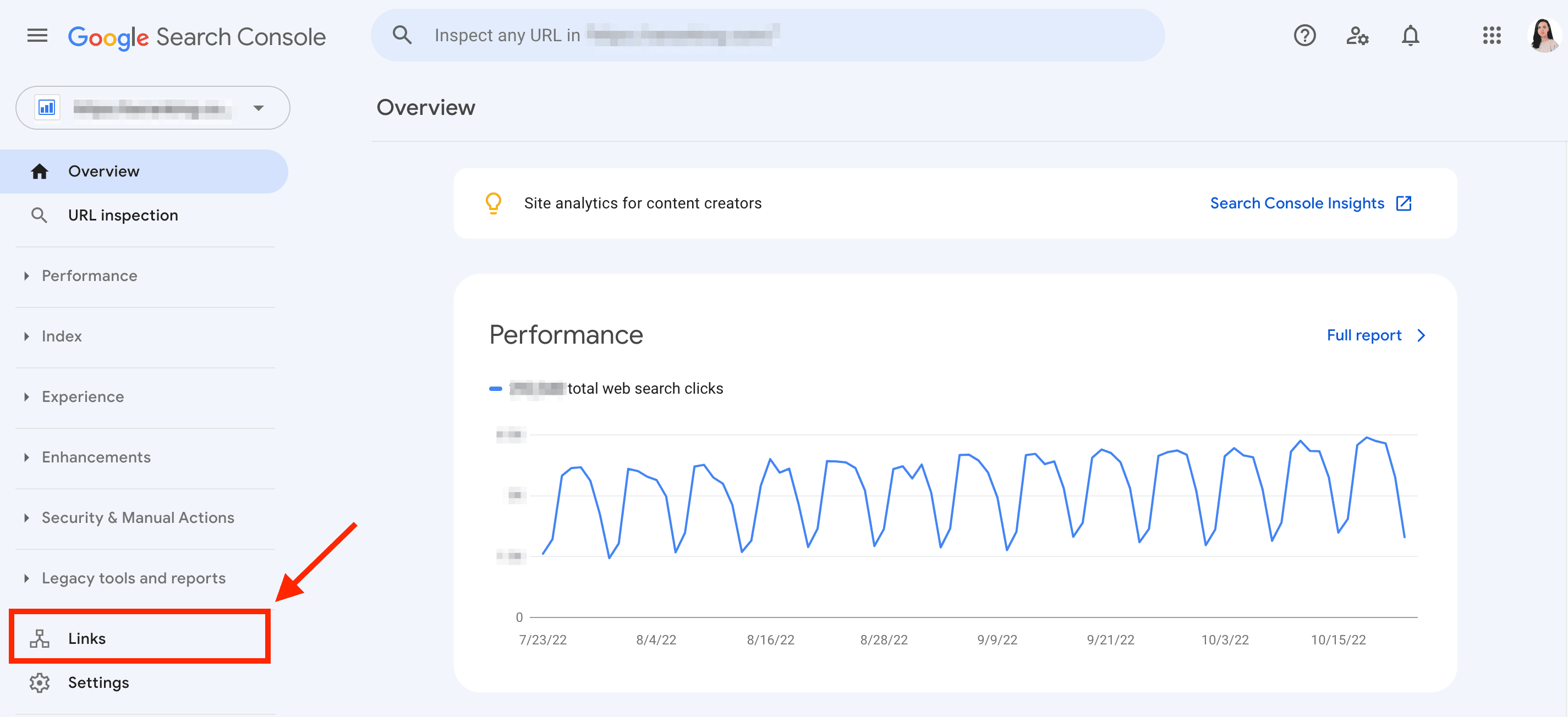
The report is divided into two blocks:
- External links
- Internal links
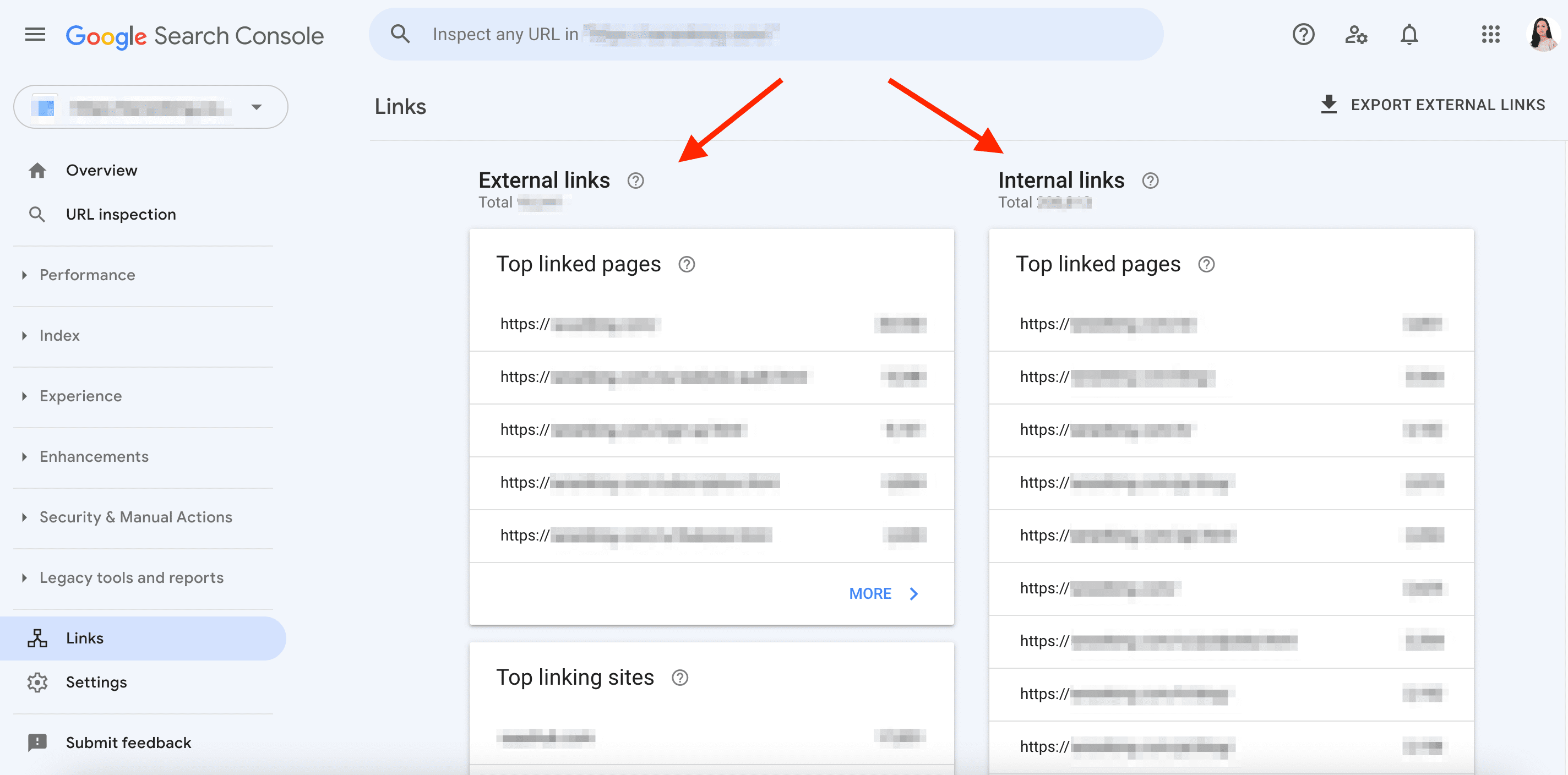
Since this guide is about external links, we’ll only focus on the first block.
On the very first page of the Links report, you’ll see a table showing the total number of links you have from outside sources as well as other important tables:
- Top linked pages
- Top linking sites
- Top linking text
Top Linked Pages table
By going to the Top Linked Pages table, you’ll see the list of pages on your website that other sites link to the most.
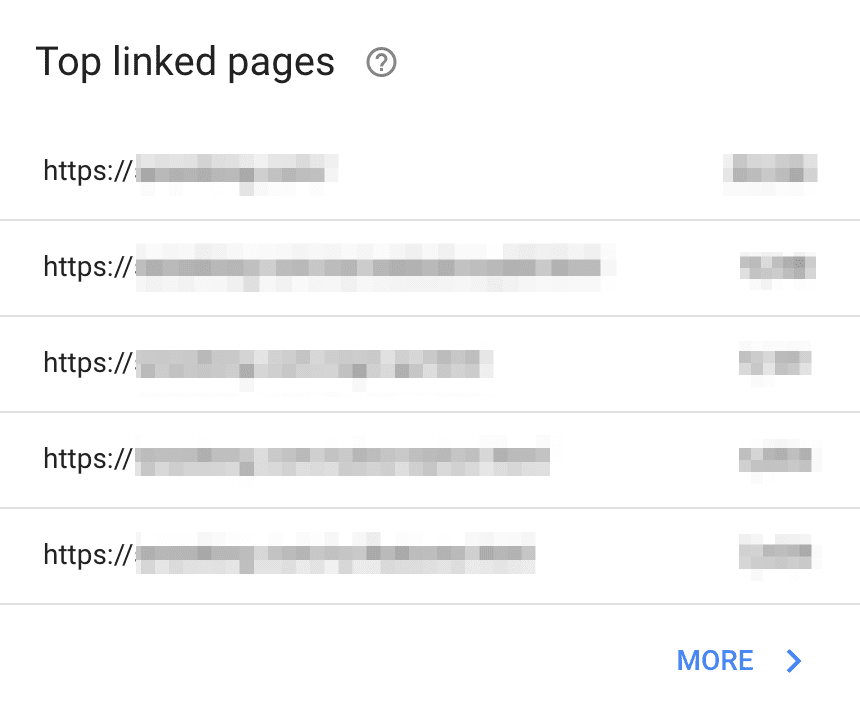
In detailed reports, you’ll get the list of pages (Target pages), the number of backlinks (Incoming links) leading to a particular page, and the number of domains (Linking sites) linking out to it.
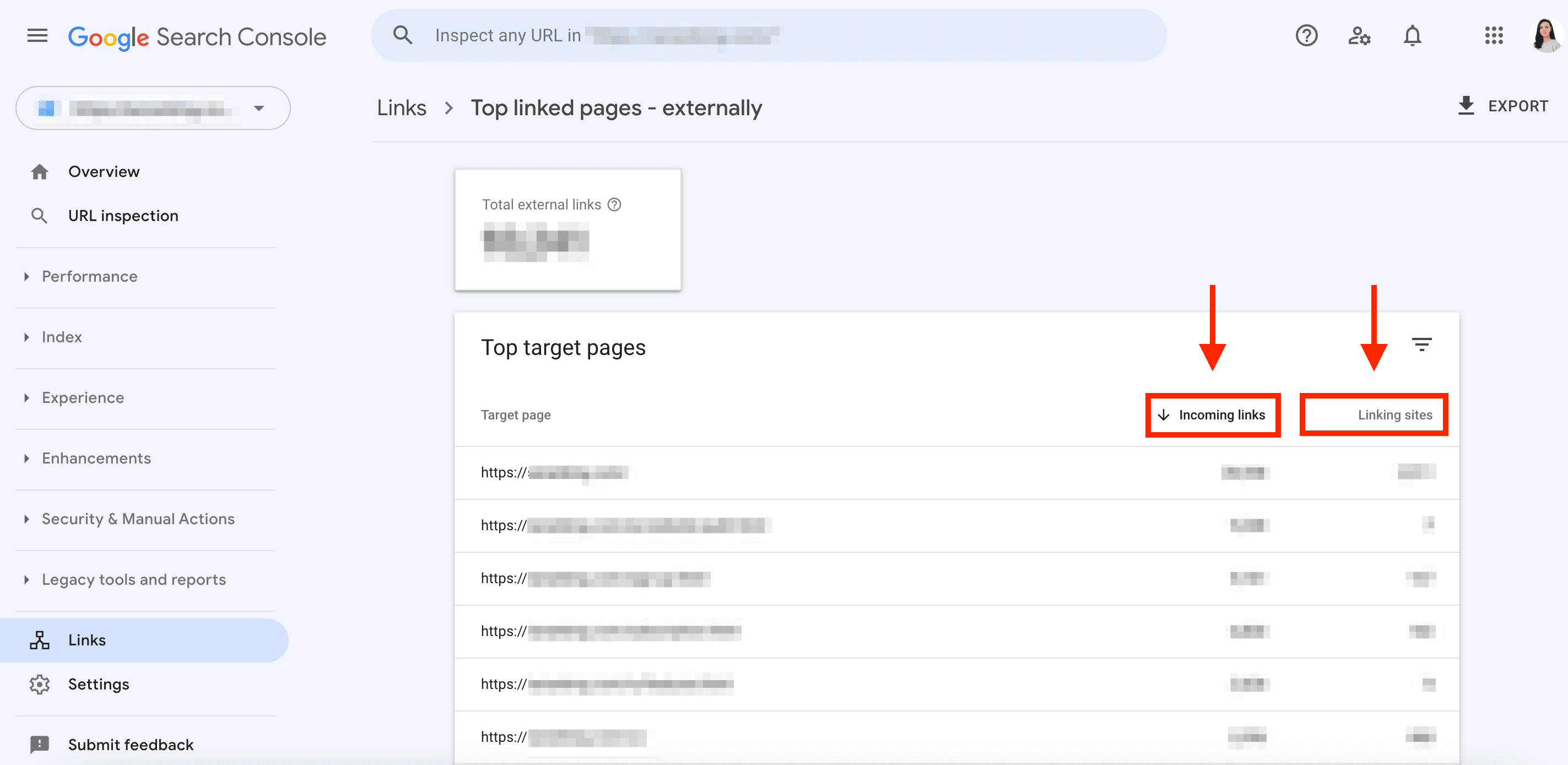
The page with the highest number of incoming links will come first. You can also sort pages by the metrics described above.
You can find links to a page by using a more detailed report that opens if you click on one of the links from your list. This report will show the sites that link out to your selected page as well as the total number of links from that site.
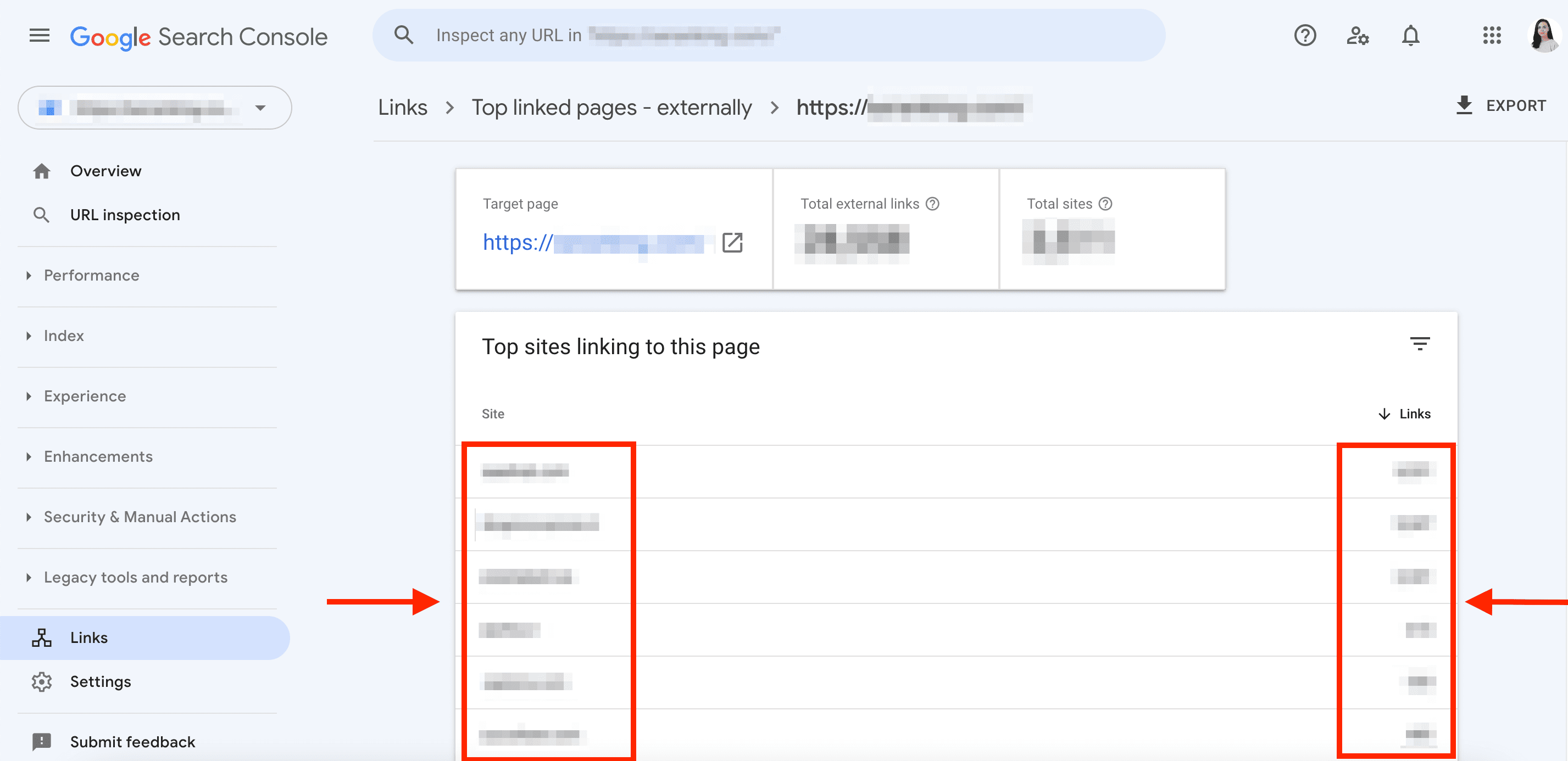
If you want to take an even deeper look at any particular site’s details, click on it to find pages that link out to a specific URL of your site.

Top linking sites table
This is a list of external properties that link out to your site. GSC shows up to 1000 domains. Sites are presented by their root domain without any subdomains.
The list is arranged by order of the number of links; from the site with the most links to the one with the fewest. You can also sort sites by their number of target pages.
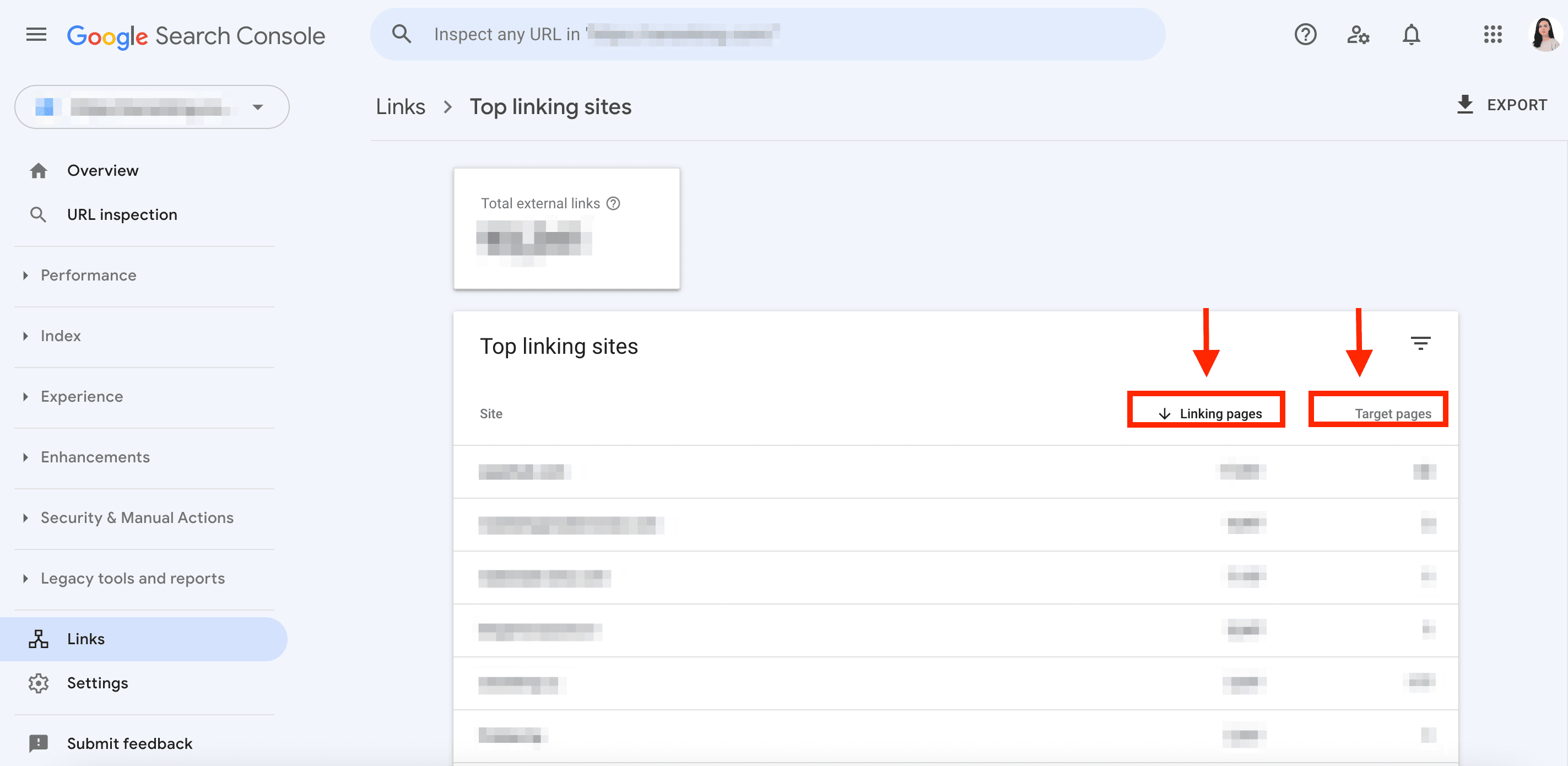
By clicking on your site of interest, you’ll see a list of all the pages it links out to. You’ll also see the total number of external links (that this site has) that lead to each target page.
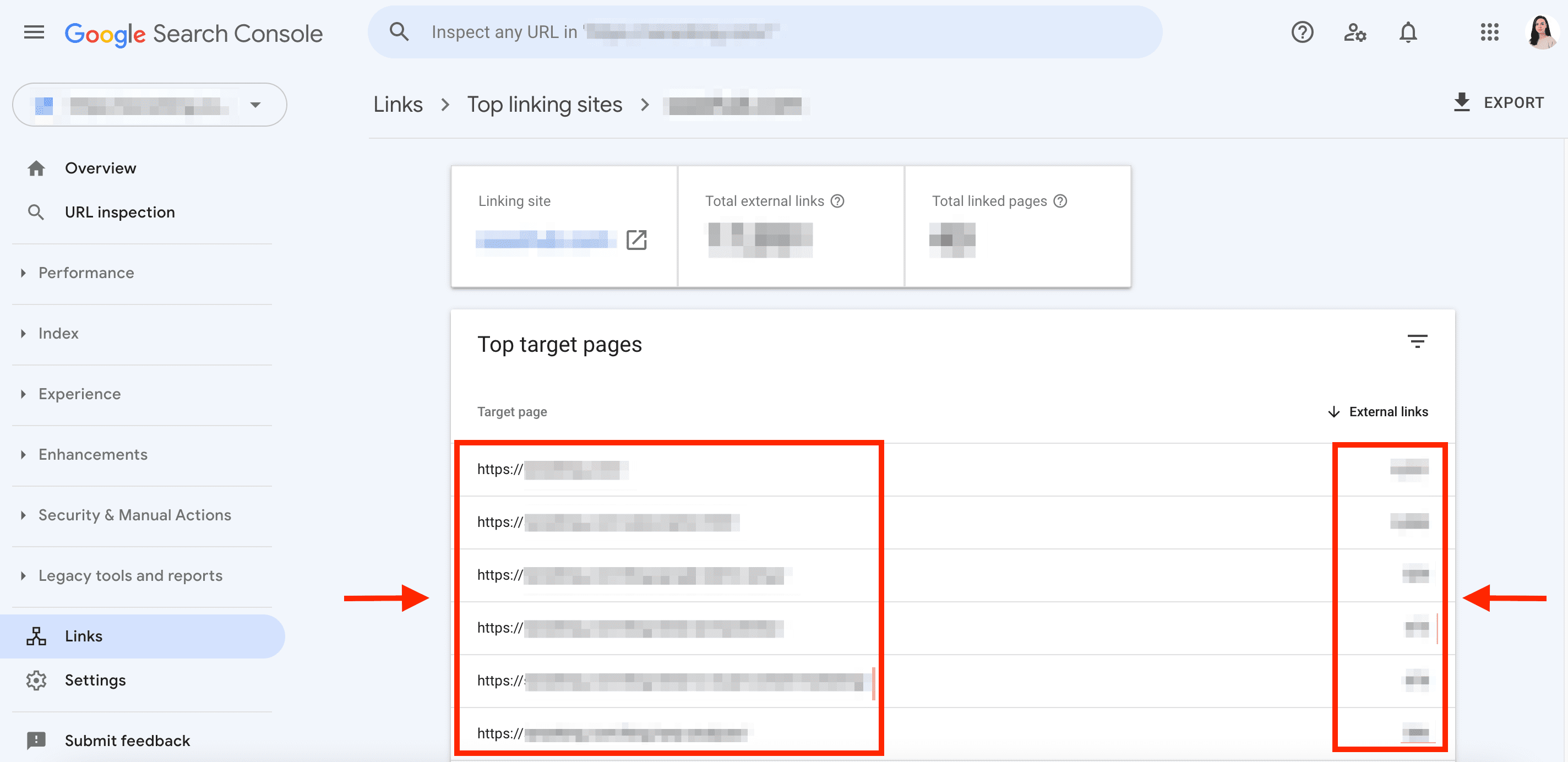
Top linking text table
Here, you can see the text used in external links, which is also called the anchor text. If multiple text variations are an exact match, and are not case-sensitive, they are considered duplicates and get merged. Link texts are grouped by exact matches and are sorted by number.
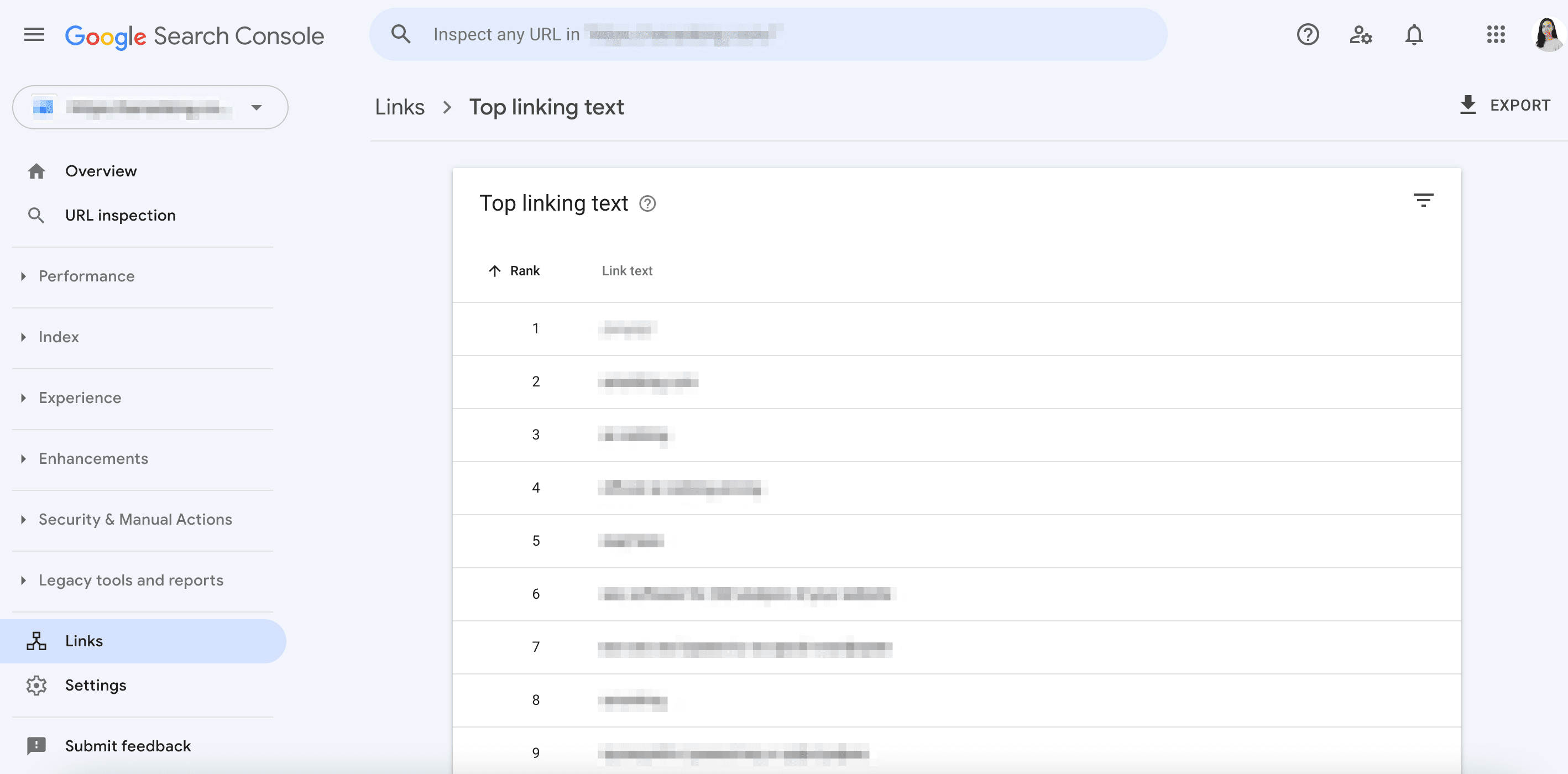
You can export data from all reports (and also export the site’s latest backlinks) in the Links tab.
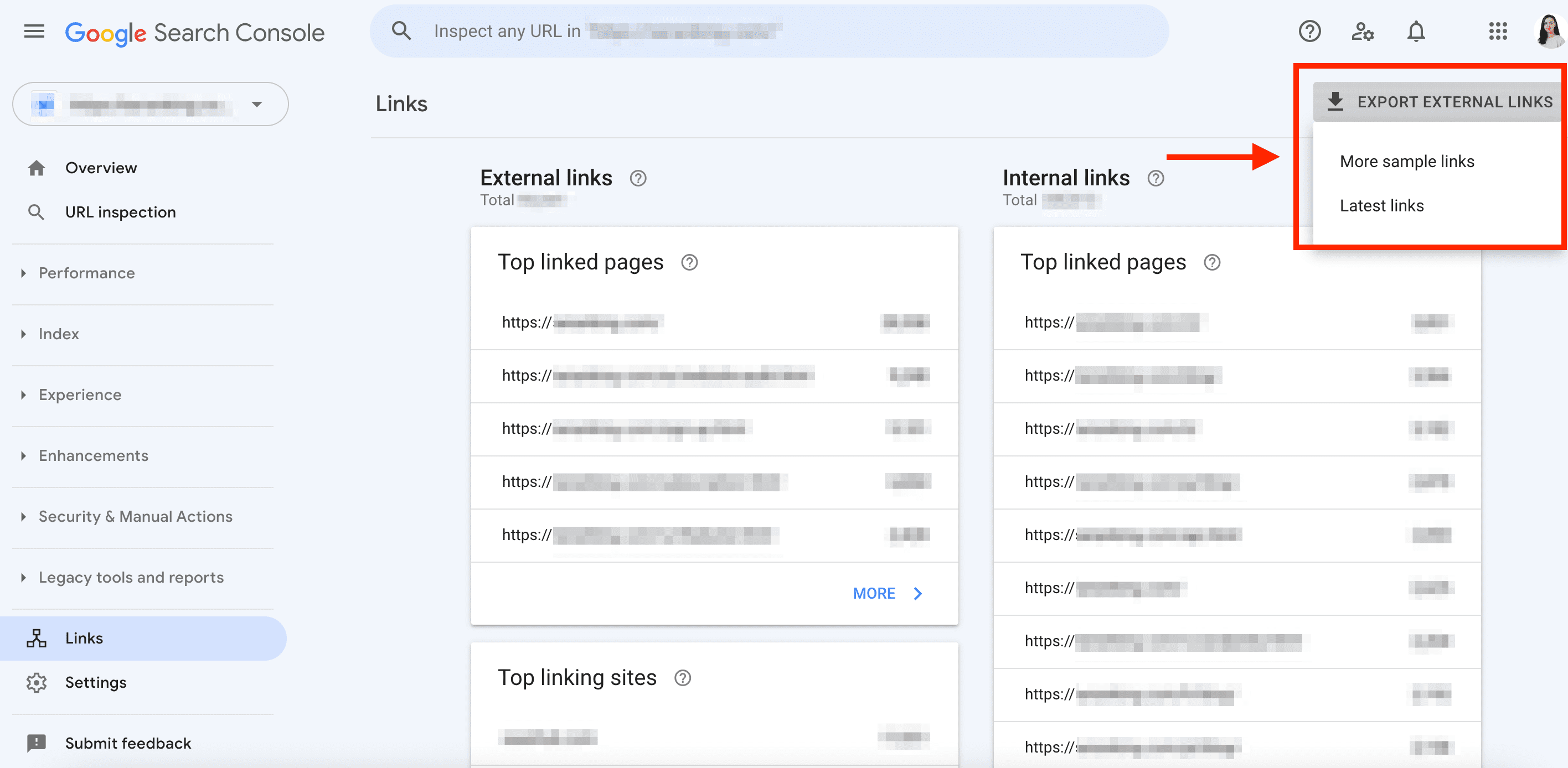
While Google Search Console is free and super helpful for external link search, it only gives you a general assessment of your backlink profile.
- It only shows 1000 domains.
- It doesn’t conveniently match the linking site (or the backlinks coming from it) with anchor texts.
- It lacks important metrics like the quality of linking domains, dofollow/nofollow attributes, etc.
Way #2: Bing Webmaster Tools
Underestimating SEO for Bing isn’t a good strategy. Bing is still popular in some niches and can even drive traffic that Google can’t.
If you’ve added and verified your site in Bing Webmaster Tools (BWT), you’ll find your website’s links (and other important metrics) in the Backlinks report. This report is available on the left sidebar and consists of three tabs:
- Backlinks for your site
- Backlinks to any site
- Disavow links
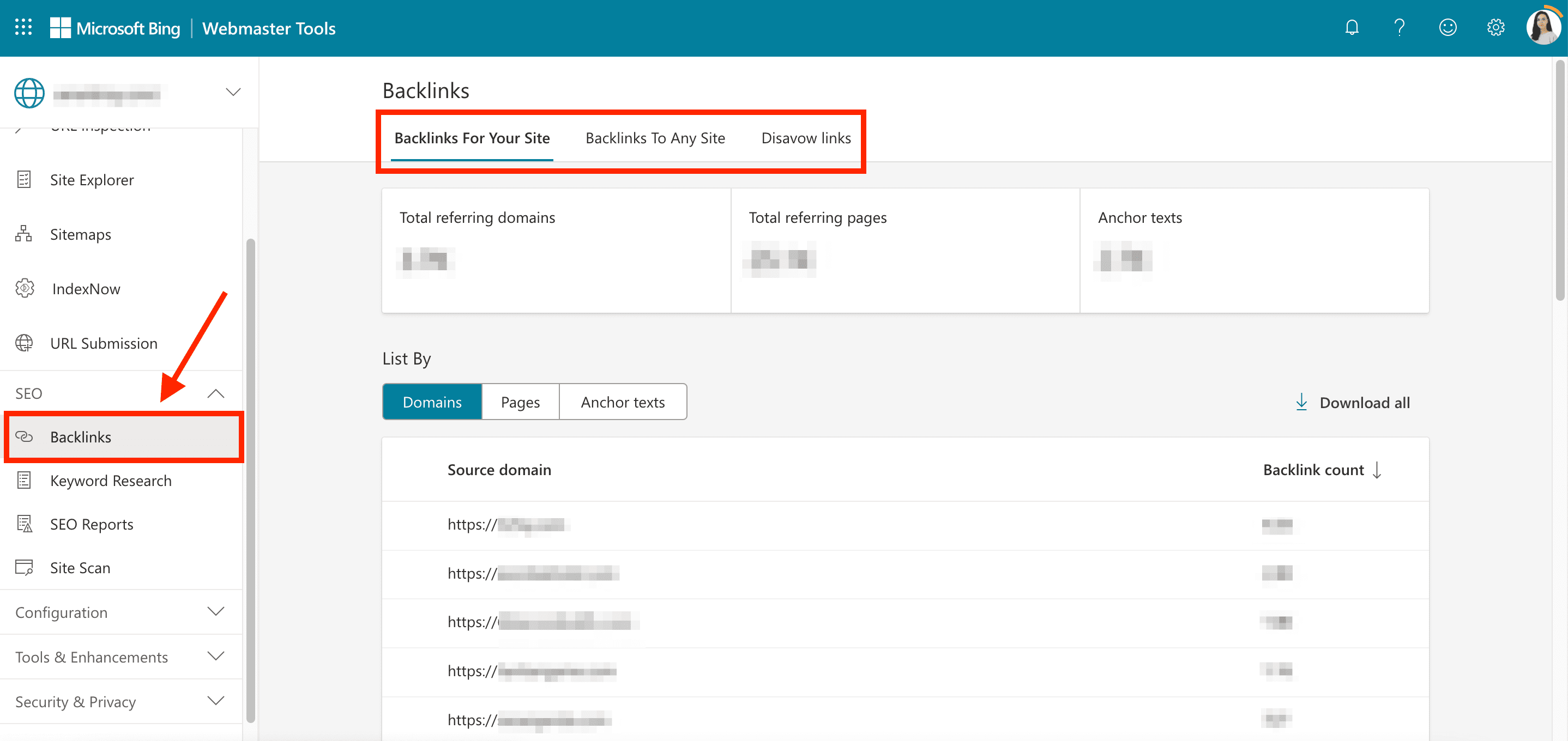
In this guide, we’ll focus on the first two.
Backlinks For Your Site tab
This tab presents:
- The total number of referring domains
- The total number of referring pages
- Anchor texts
It is also divided into three sections:
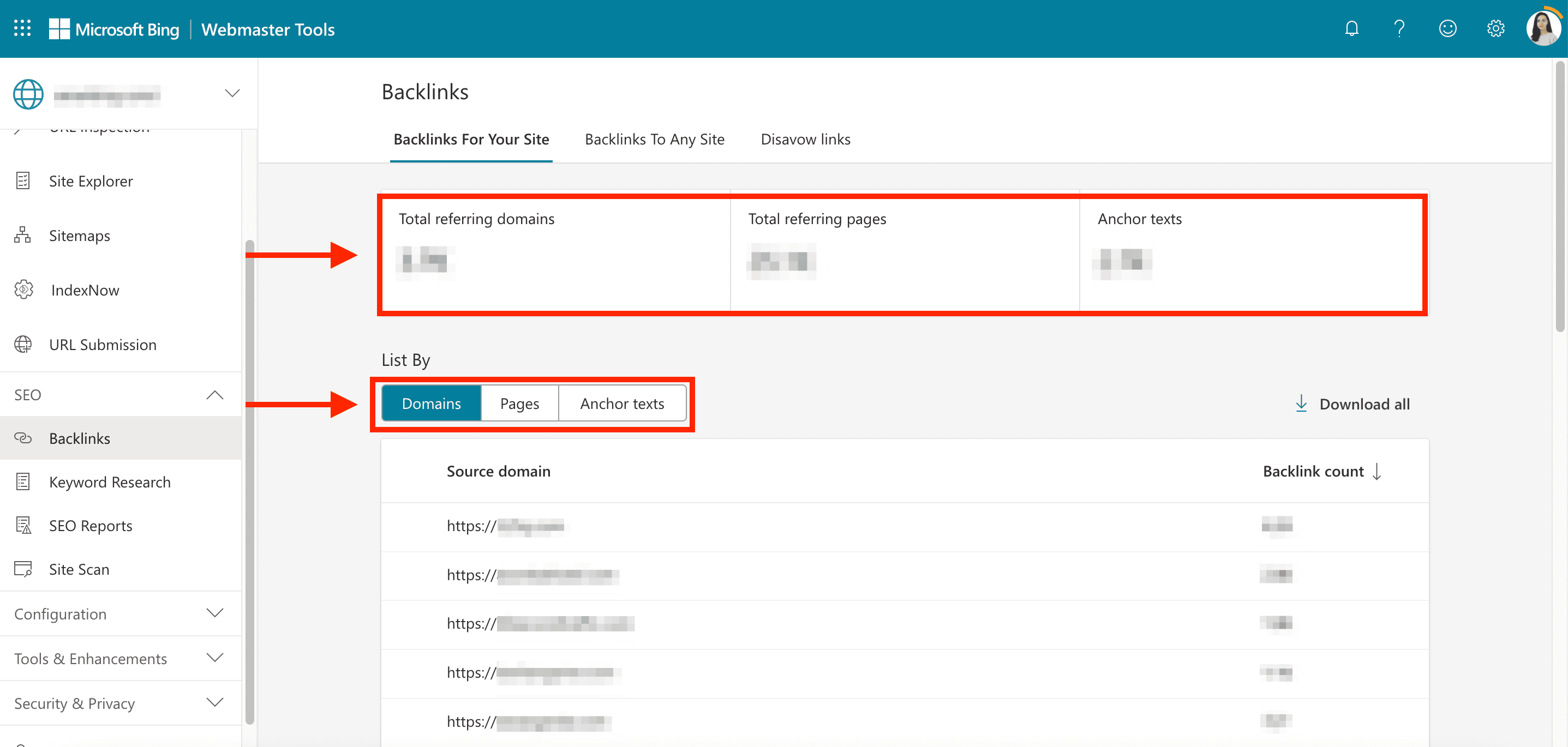
The Bing Webmaster Tools Help Center notes that the data you see isn’t a complete backlink profile but a representative set.
Domains
This report lists the unique domains (up to 1,500) that link out to your site. It also lists the number of backlinks coming from each domain.
By clicking on a domain, you’ll get more details, namely the:
- Number of referring pages from the selected domain (1)
- List of pages that link out to your site (2)
- Link text (if one was used) (3)
- Pages on your site that are linked to (4)
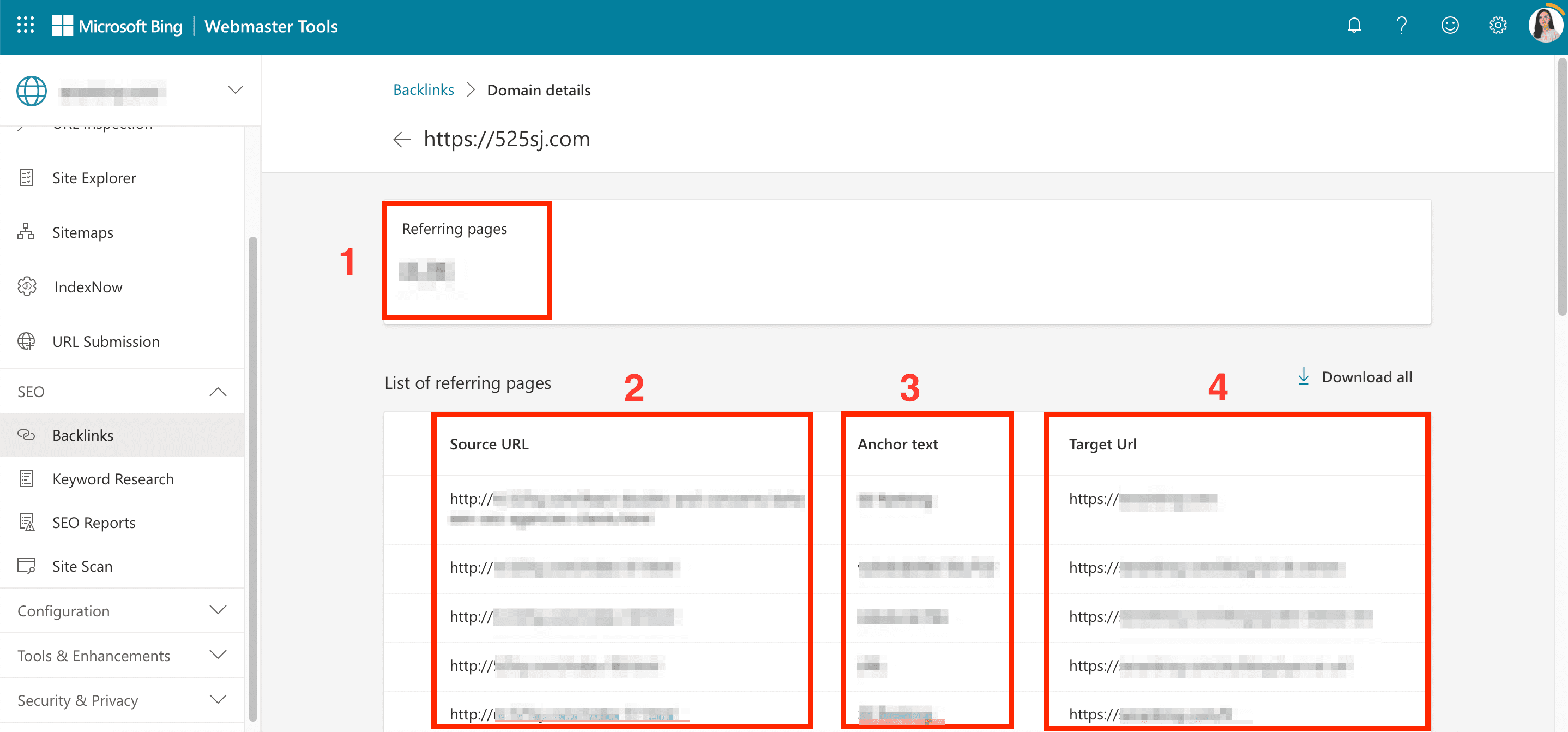
BWT displays up to 10,000 backlinks per domain.
Pages
Here, you’ll see a list of pages that link out to your site (1), the link text used (2), and the target page on your site that’s linked to (3).
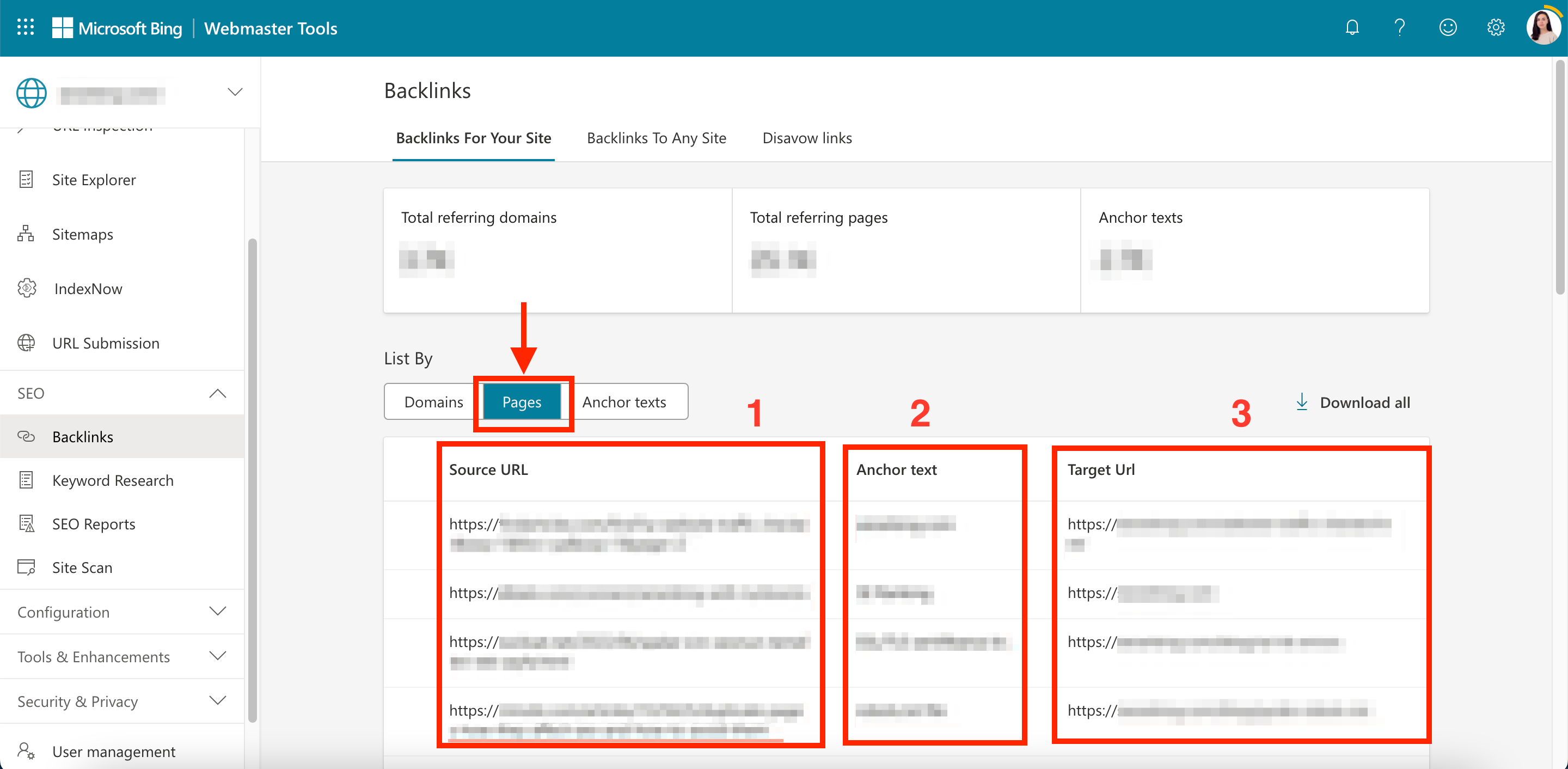
You can see the data for up to 100,000 URLs.
Anchor Texts
This report shows anchor texts that other websites use to link out to yours and the number of backlinks that include each anchor text from the list. You can see referring pages by clicking on the anchor texts in the list.
BWT displays up to 1500 anchor texts that you can export. It also displays up to 10,000 referring pages.
Backlinks To Any Site tab
This is a new feature announced back in 2020. You can use it to compare the backlinks of sites similar to yours.
You can add up to two competitor sites. Compare your site with theirs to find any backlink overlaps and gaps.
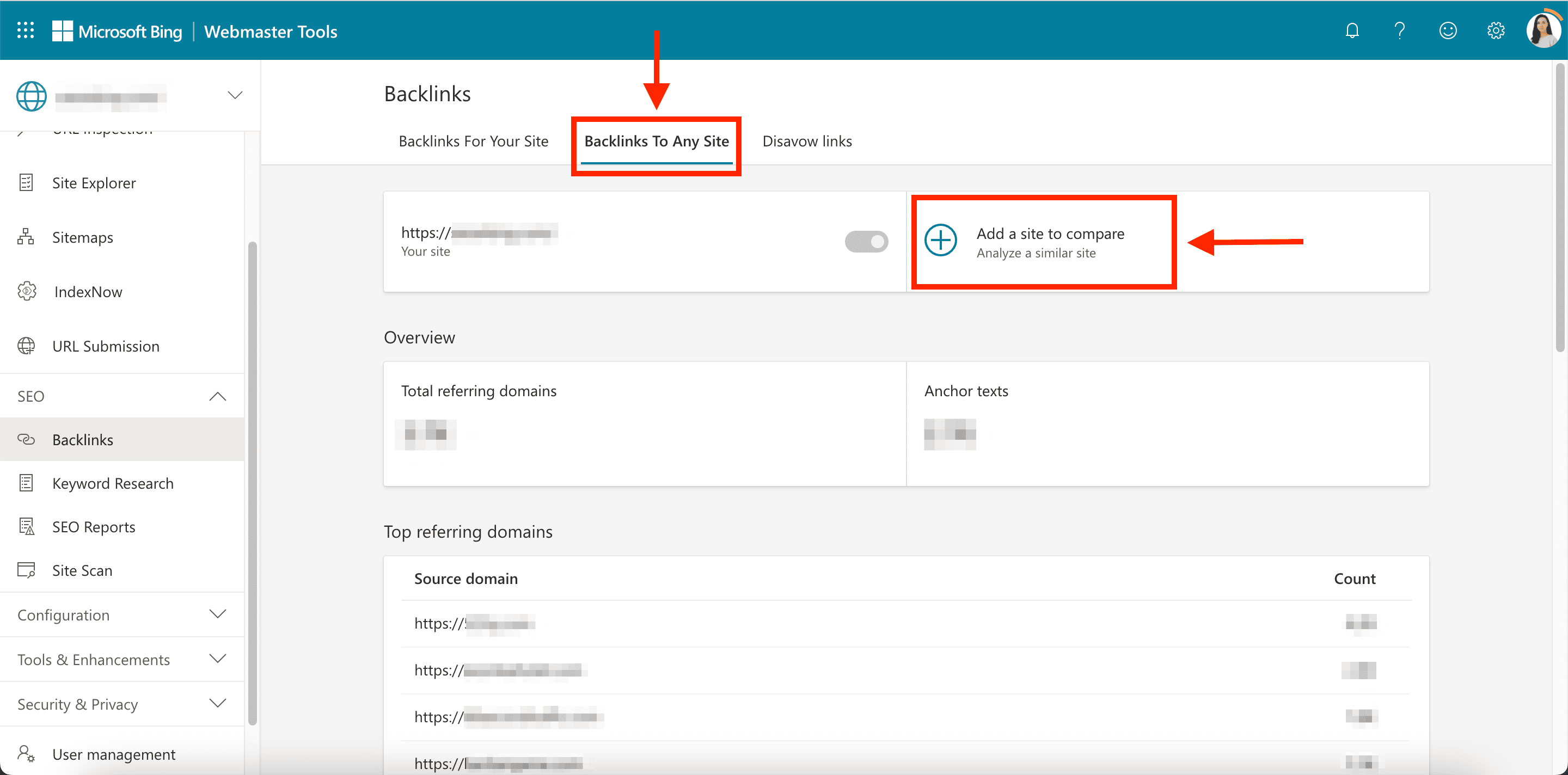
The Overview section displays the total number of referring domains (and the most commonly used anchor texts) by each site.

The Total referring domains section shows each site’s top 10 source domains alongside their backlinks count.
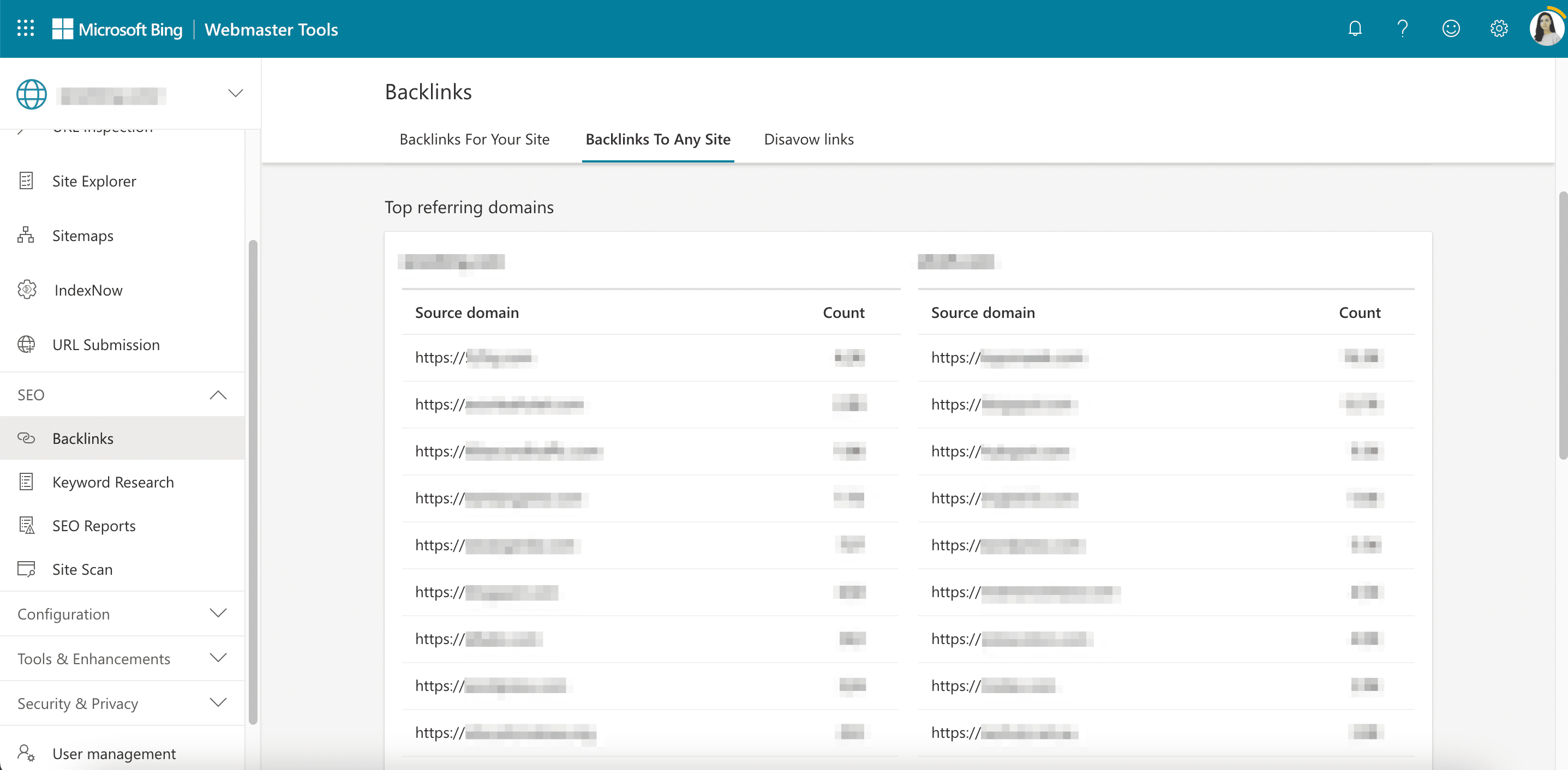
To get a deeper analysis, go to view a detailed report. Here you’ll get a complete backlink overview of the specified competitor along with their anchor texts and target URLs.
For a more convenient comparative analysis, use one of these three filters:
- Show all data
- Show only common domains
- Show domains not linking to my site
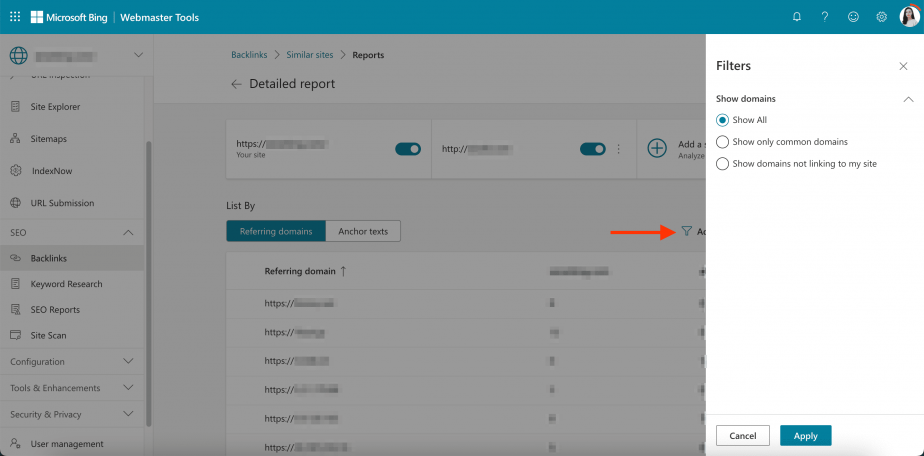
As a free instrument, Bing Webmaster Tools is quite helpful when you need to check a website’s backlinks, but you only get a surface level check from it. Just like Google Search Console, BWT limits you in terms of the number of accessible domains, backlinks, URLs, and anchors. It also doesn’t provide quality indicators.
Bing, however, has one pretty significant advantage. With it, you can compare your backlink profile with those of your competitors. But it still isn’t enough for deep backlink analysis.
Way #3: SE Ranking
SE Ranking has many professional SEO tools for website audits, competitor analyses, keyword research, and of course, backlink monitoring and checking. Backlink Checker is the go-to assistant for working with backlinks. Using this backlink finder, you can get a complete view of your backlink profile and measure each and every backlink that links to your site using various parameters.
By saying “each and every,” we aren’t exaggerating. SE Ranking has one of the most extensive link bases:
- 3T backlinks indexed
- 262M domains indexed
- 7B pages crawled daily
The Backlink Checker’s overview report provides a lot of useful information about your backlink profile, including:
- Domain Trust: aggregated domain quality score developed by SE Ranking. This metric provides insights into the site’s backlink profile quality and makes it easy to compare them.
- Page Trust: aggregated page quality score developed by SE Ranking. This metric’s calculation methodology is similar to the Domain Trust estimation, but instead each URL is measured separately.
- Anchor texts: the most common anchor texts used in your backlinks.
- Dofollow/nofollow backlinks: the ratio between dofollow and nofollow backlinks.
- Referring domains: the total number of referring domains, including those linking out only to the homepage or to pages within the site. This metric also looks at how your referring domains changed over a week/month/3 months/6 months/one year.
- Total backlinks: the total number of backlinks, including links to the home page and other pages, and how they changed over a week/month/3 months/6 months/one year.
- Referring .edu and .gov domains: the total number of backlinks from .edu and .gov domains.
- IP addresses and subnets: the total number of unique IPs and subnets linking out to your website.
- New & lost referring domains: the history of acquired referring domains.
- New & lost backlinks: the history of acquired backlinks.
- Backlink profile distribution map: the domain zones and countries your website gets backlinks from. It’s especially useful if, for instance, you have a local domain like co.uk
You can also use SE Ranking’s Backlink Gap Analyzer to compare you and your competitors’ backlinks. You can analyze up to five of them. We’ll cover this further in an upcoming section.
For now, let’s take a look at how to find backlinks to a website using Backlink Checker. We’ll also go over any additional data that this tool can give you. To start, go to the detailed reports in the side menu.
Referring domains
This report displays all the info about referring domains that you’ll need, including:
- The total number of referring domains (1)
- The total number of backlinks and IP addresses that link out to your site (2)
- Domain distribution by country code (3)
Going down a little further (4), you’ll see a list of all the domains that link out to your site, along with the domain trust score, the number of backlinks from that domain to your site, and the **** SE Ranking first found that domain.
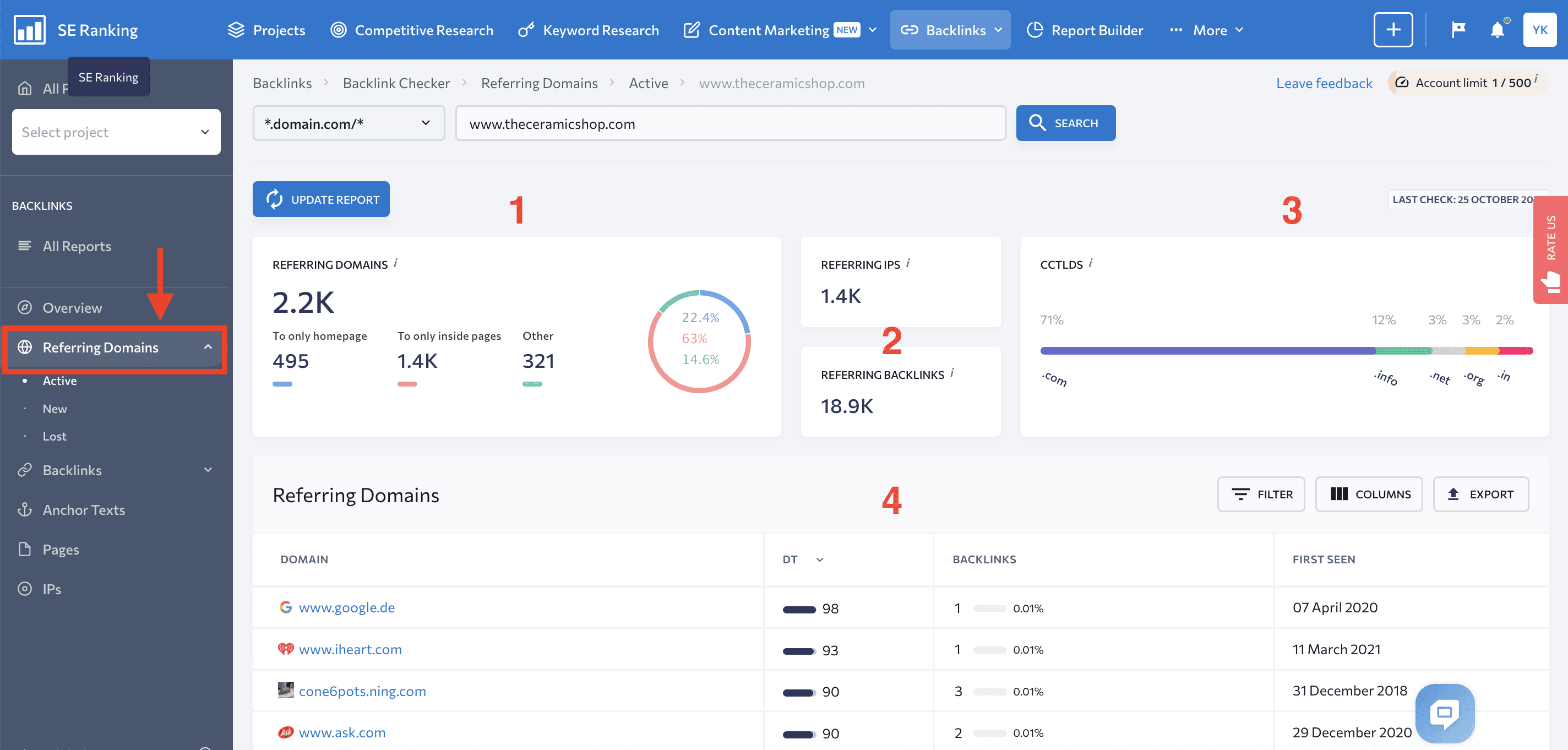
By clicking on the arrow next to a domain’s backlink count, you’ll see an expanded list with all the backlinks (and some other essential information), including:
- Domain Trust
- Page Trust
- Anchor Text
- Target URL
- Link type (dofollow/nofollow) and whether it was featured in the text on the image
- First and last seen dates
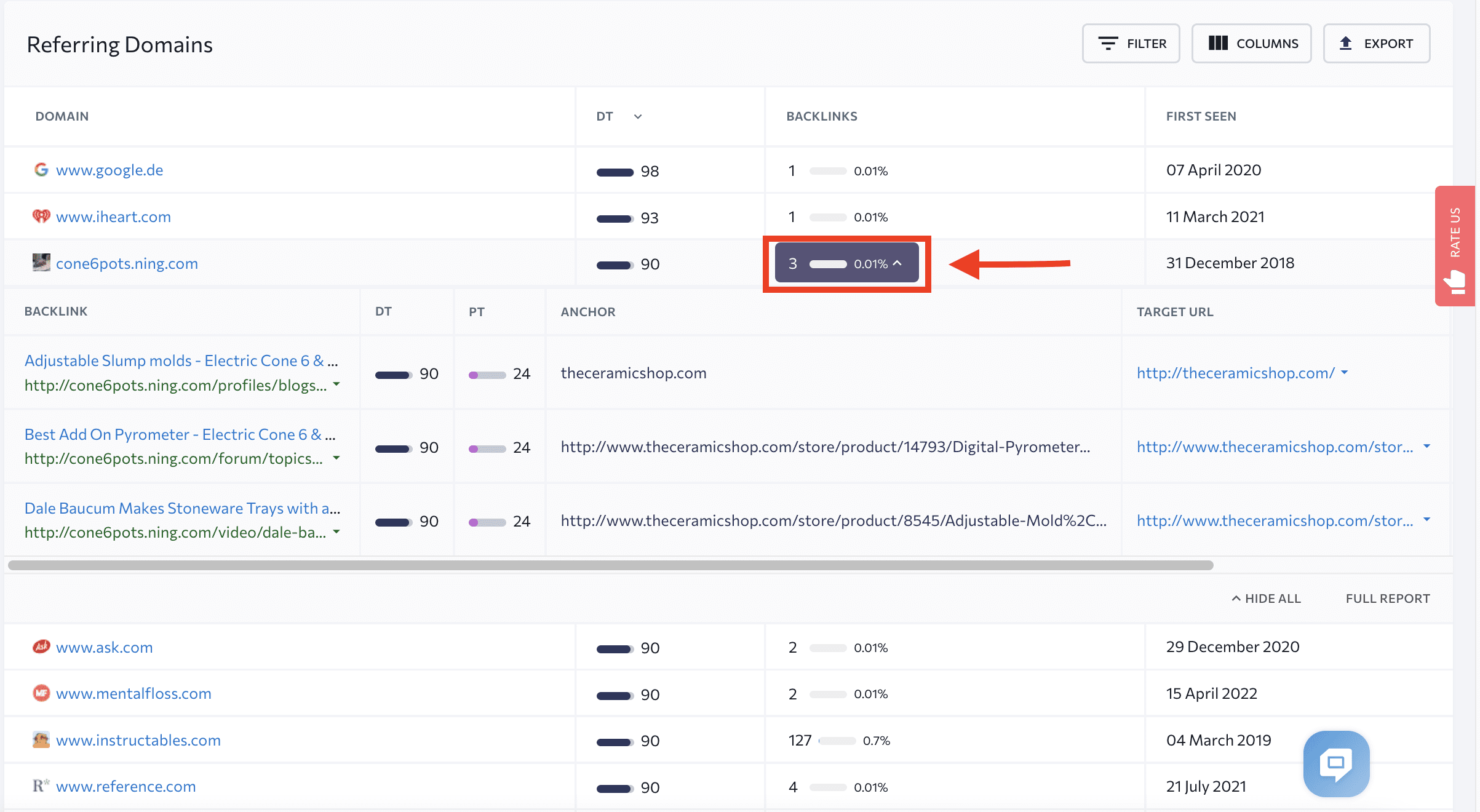
The New and Lost subreports in the sidebar will show you the domains that started linking out to you over the last week, month, 3 months, 6 months, or a year. It also shows you the referring domains you lost over that same period.
You can customize reports by choosing which columns to include and by filtering the values. You can also export reports as CSV or XLS files.
Backlinks
Traditionally, the Backlinks report starts with a short summary that presents:
- The total number of backlinks
- The total number of IP addresses and referring domains linking out to the analyzed domain/URL
- The distribution of dofollow/nofollow backlinks
The table below shows a list of all backlinks and detailed information about them, including the:
- Link to the page containing the backlink
- Domain Trust
- Page Trust
- Backlink anchor text
- Target URL
- Backlink type
- First seen ****
- Last analyzed ****
You can get additional data by clicking on the arrow next to the backlink or target URL.
Just like in the Referring Domains report, you can analyze new and lost backlinks. You can also customize and export reports.
It only takes one click to export all backlinks (found by the Backlink Checker) to the Backlink Monitoring Tool. Do this to keep your finger on the pulse (or status) of your backlinks and promptly respond to any problems.
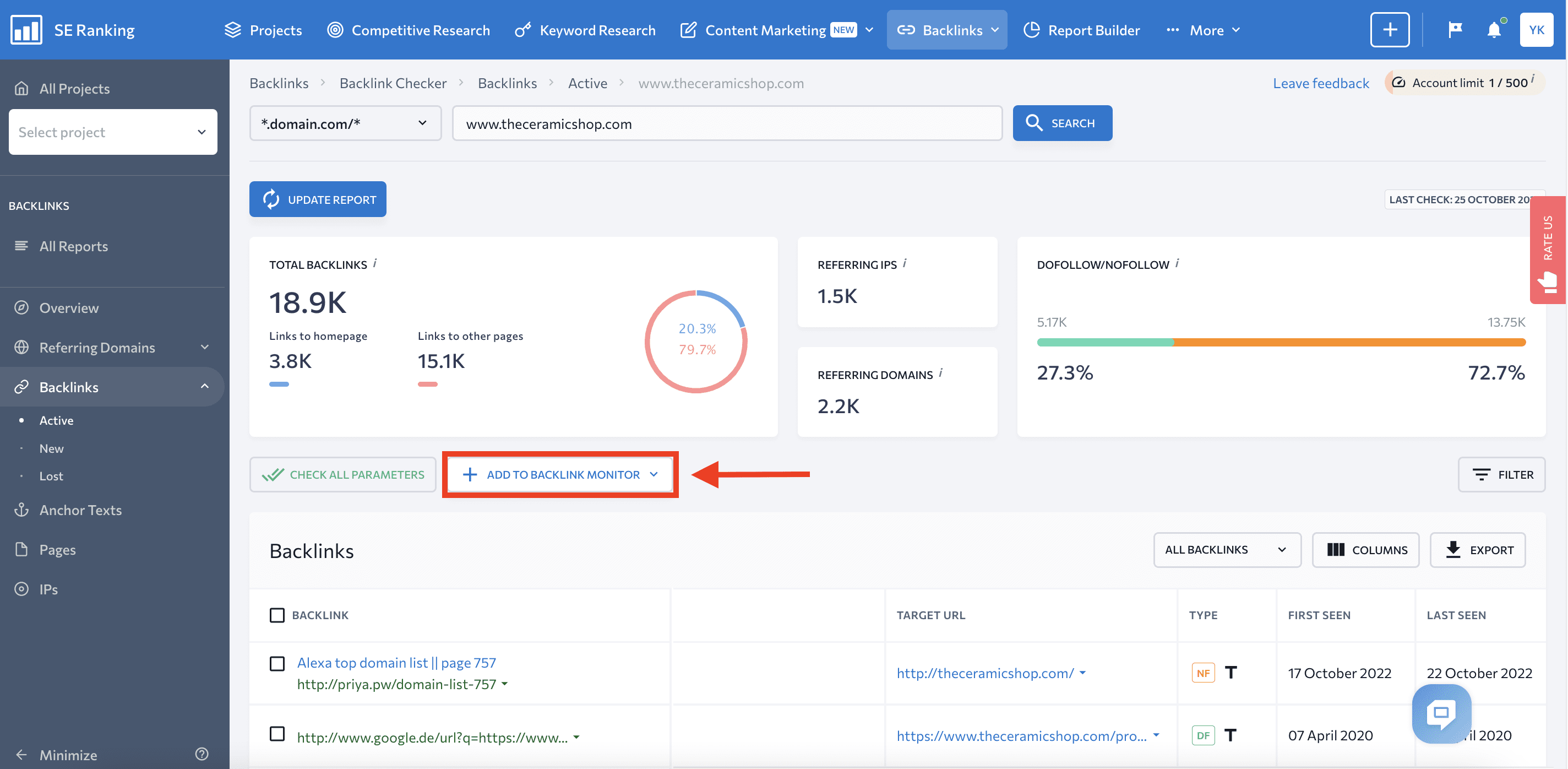
If you want to learn more about how to add backlinks for monitoring, we devoted an entire section to it in this guide. Keep reading to learn about that and more.
Anchor texts
This report presents the most common anchor texts used in backlinks. It also shows the referring domains linking to your site. Each anchor comes with the number and proportion of backlinks (and referring domains) that are using it.
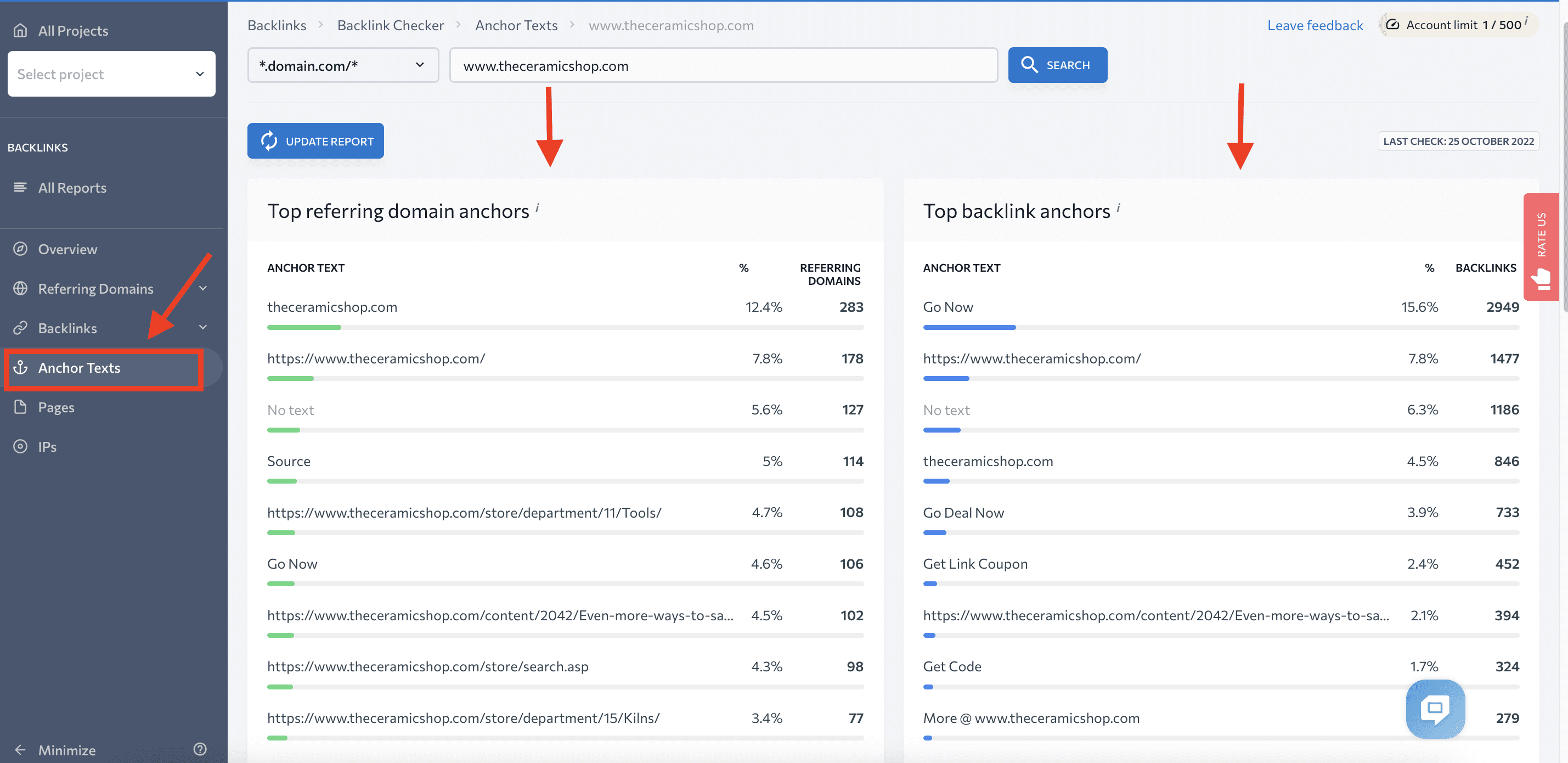
You can sort anchors by:
- The number of words in the anchor.
- Their referring domains.
- Backlinks and their type.
- The **** of the first and latest analysis.
If you click on the number of referring domains or backlinks, you’ll see more detailed information about the domains and links that are using this anchor.
This report will help you understand your backlink profile’s health and quickly identify spam or toxic backlinks that typically contain irrelevant anchor text.
Pages
This report shows all the pages on your site that have links to them. Here you’ll see the number of backlinks and domains linking out to each page.
Click on the arrows near the backlink and domain values to get detailed information on external links and to find sites that link out to each URL.
Use filters to organize page lists by the number of backlinks or referring domains that they have. Then export reports in CSV or Excel format.
These reports will help you understand which pages are getting the most backlinks versus pages that are lacking them and are in need of attention.
Backlink Gaps
You can also use SE Ranking to compare you and your competitors’ backlink profiles. The new Backlink Gap Analyzer finds domains and URLs linking out to your competitors but not to your main domain or URL. It also finds the backlinks you share.
Find this tool under the Backlinks tab within the top menu.
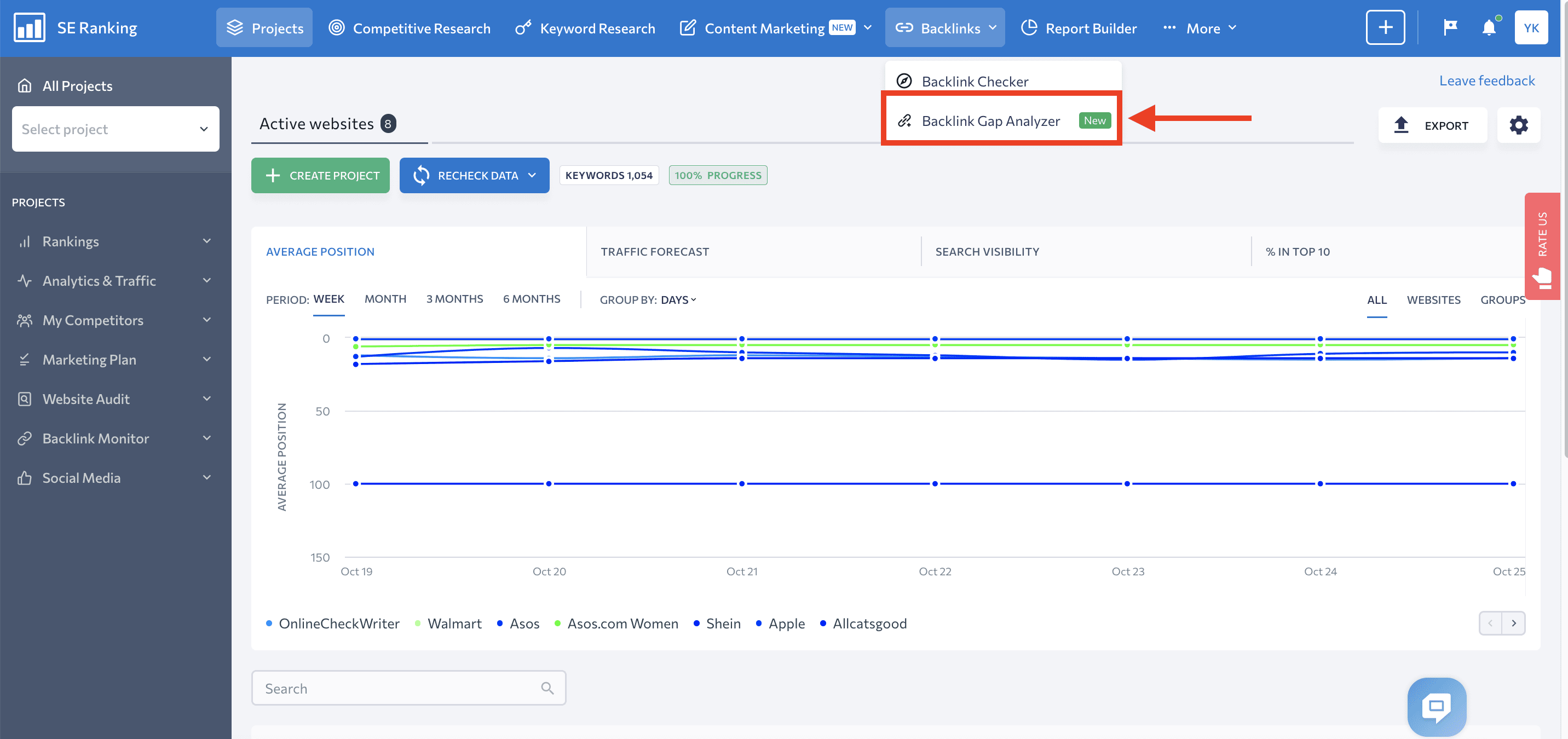
Enter the main domain or URL you want to compare (yours) and add up to 5 competitors.
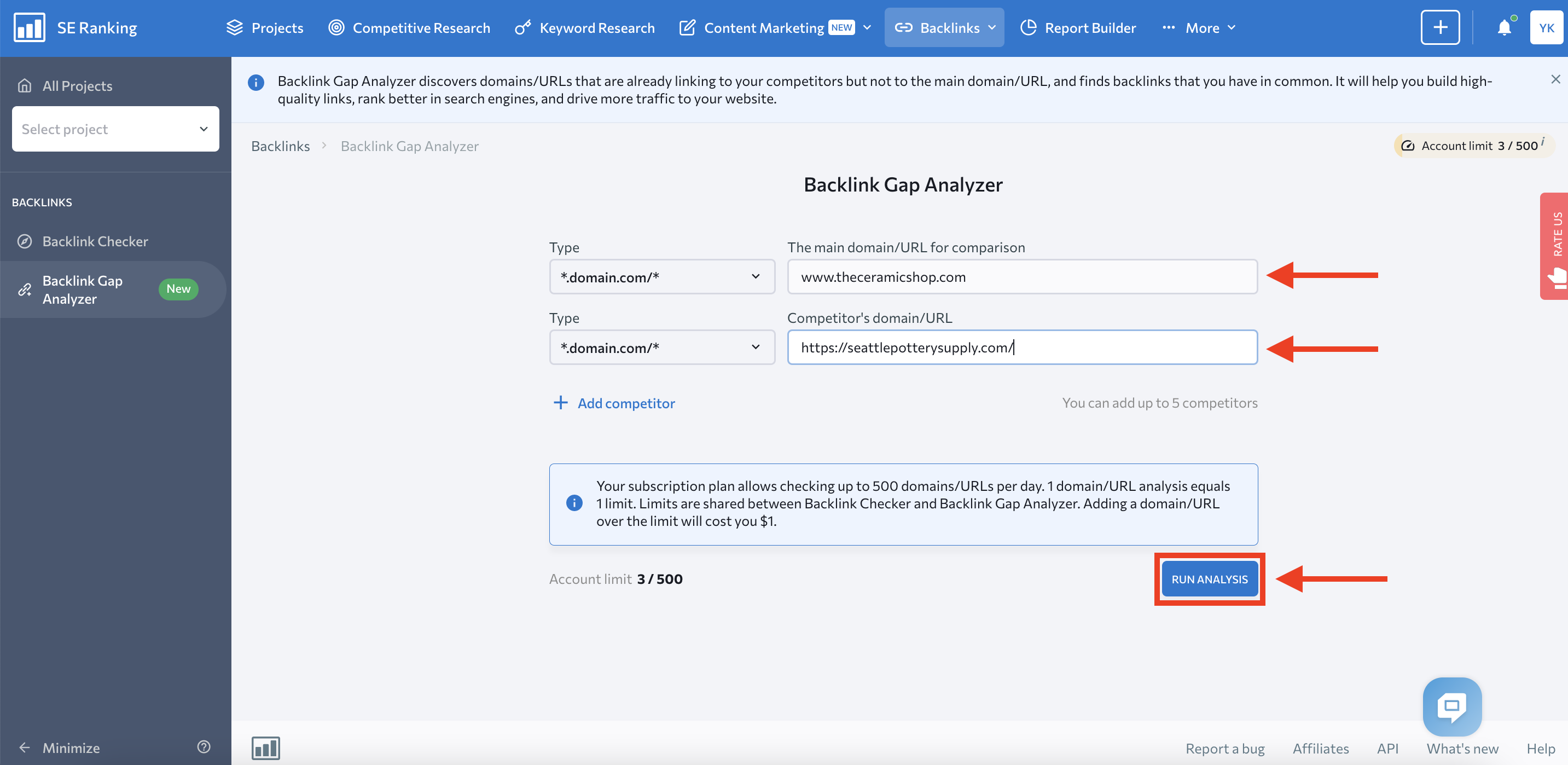
The report will contain two tabs: referring domains and backlinks.
The first table will show a list of:
- All referring domains.
- The domain trust score.
- The total number of backlinks from each referring domain to the analyzed websites.
- The number of backlinks that each competitor has.
These are the default filters, but you can customize them. For example, for better visualization, you can choose the show all backlinks filter and add your website to the table.
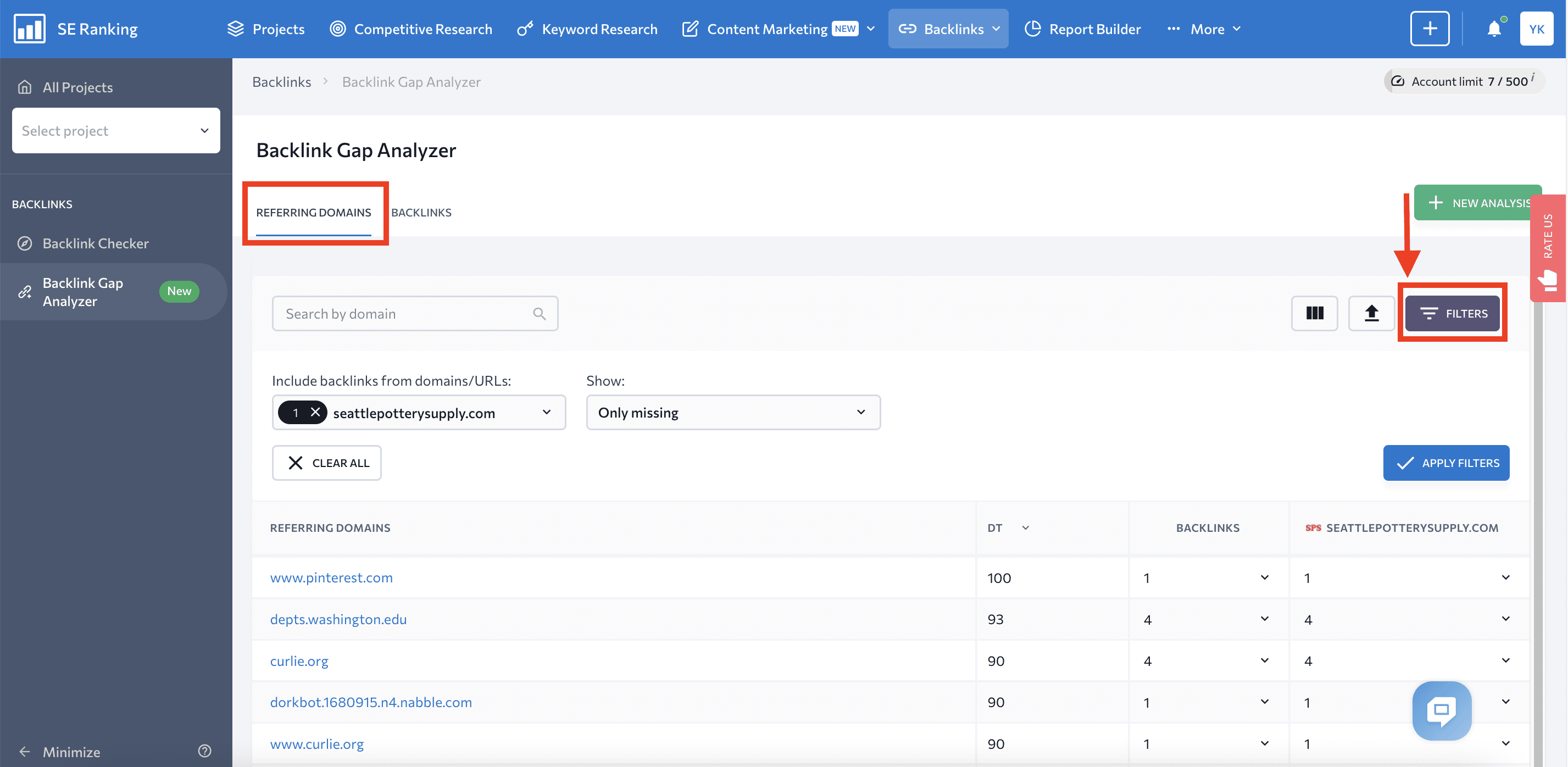
Find additional information by clicking on the arrows next to the values in each column.
The second table will show you a list of all the backlinks carried by the URLs you entered. It also shows their quality assessment metrics.
The same filters apply here as for the Referring Domains table. You can choose to see “Only missing backlinks” or “All” to compare your backlinks with those of your competitors.
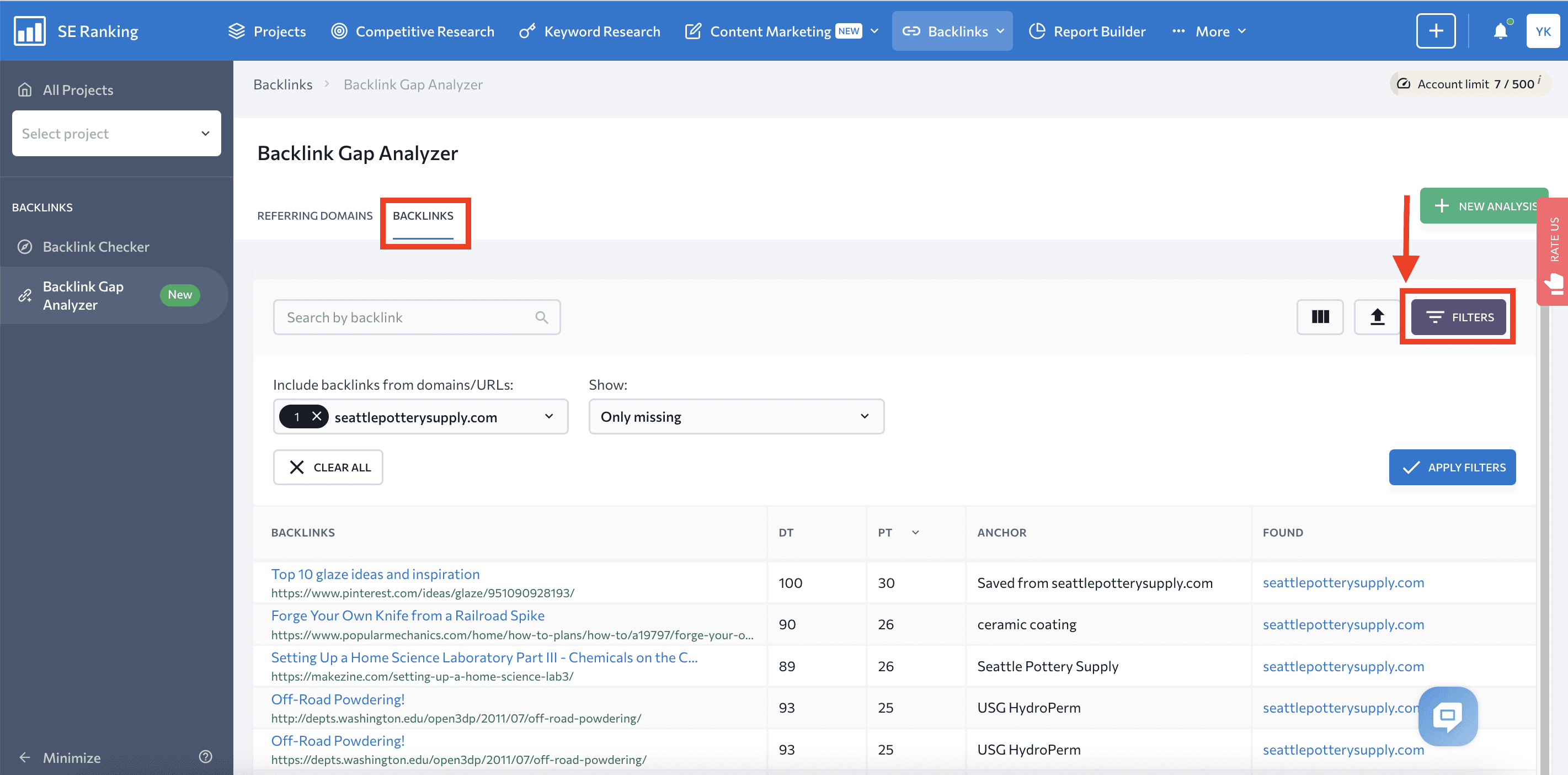
SE Ranking has more advantages than the other free tools. It provides you with the most complete information on backlinks and does so in an easy-to-follow format.
- SE Ranking’s backlink tools show you all the important metrics for backlinks, referring domains, and anchors.
- There are no limits for backlinks or domains in reports. You can view, filter and sort all of your links.
- You can customize each dashboard and report according to your needs.
- You can analyze up to five competitors.
- All reports are exported in one click. You can track the status of your links week by week by adding them to the Backlink Monitoring Tool.
What to do once you’ve found all your backlinks
Just finding backlinks isn’t enough. You need to monitor them consistently, too.
Why? Because backlinks can change. When backlinks change, so does the quality of your website’s SEO.
For example, some of your best backlinks could get lost. If they do, you’ll need to replace them with new ones (preferably of the same quality). You may also notice many spam links. Disavow these right away because they weaken your backlink profile and lower your positions in the SERP.
Here are some next steps.
Analyze your backlinks to build a strategy around them
Evaluate the strength of your backlink profile. Find out who links to your site and whether this source is relevant and trustworthy. Compare your backlink profile with that of your competitors and use what you find as a reference point from which to build your own backlink strategy.
See for yourself what content your competitors are creating that gets more backlinks. Then come up with ways to create content of your own that’s similar to it but better. Irina Nica, Senior Marketing Manager of Product Awareness at Hubspot, believes that the following types of content attract the most backlinks:
- Posts backed by original data
- Expert interviews and thought-leadership articles
- Ultimate guides
Consider creating the types of content described above, but always make sure the type of content you create is appropriate for your niche.
Look into guest posting, too! According to feedback we received from our clients, guest posting was one of the most effective ways for them to build a healthy backlink profile.
To make guest posting work for you:
- Look for hosts in the same niche and industry as yours.
- Make sure that the host’s blog readers are interested in your services, products, or brand.
- Create unique, valuable, and readable content.
Analyze top linked pages
Figure out which pages get the lion’s share of backlinks. Make sure that the most important pages on your site are among them. Your most important pages are the ones that drive the most traffic and have the highest conversion rates.
If these pages don’t get enough quality backlinks, they won’t rank high and certainly won’t bring you the results you want. Consider making some changes to your link-building strategy by finding ways to attract more backlinks to your target pages. An easier solution, though, would be to direct internal links from the most linked pages on your site to your target pages.
Add backlinks that you want to monitor
SE Ranking allows you to connect your Google Search Console with a project on the platform. This means you can export your backlinks to the Backlink Monitoring Tool not just from Backlink Checker but also from Google Search Console.
Wondering what makes this feature so awesome? To put it plainly, this integration feature lets you merge all the tools you need for backlink monitoring (and analysis) under one roof. This includes a full list of links that Google sees and all the essential data from SE Ranking.
The Backlink Monitoring Module shows you different graphs so you can:
- Evaluate the total number of backlinks and their growth dynamics.
- See how many backlinks were added and lost in different interval periods.
- Analyze the ratio of backlinks leading to the homepage and other pages.
- Asses the ratio of dofollow and nofollow backlinks.
For more convenient monitoring, you can also group backlinks into folders (for example, by type or ****).
The tabs: Domains, Anchor Texts, Pages, IPs/Subnets, and Disavow will show you detailed information on:
- Referring domains.
- Texts used in the backlinks.
- Pages linking out to your website.
- Unique IPs and subnets linking out to your website.
- Links that you marked as disavowed.
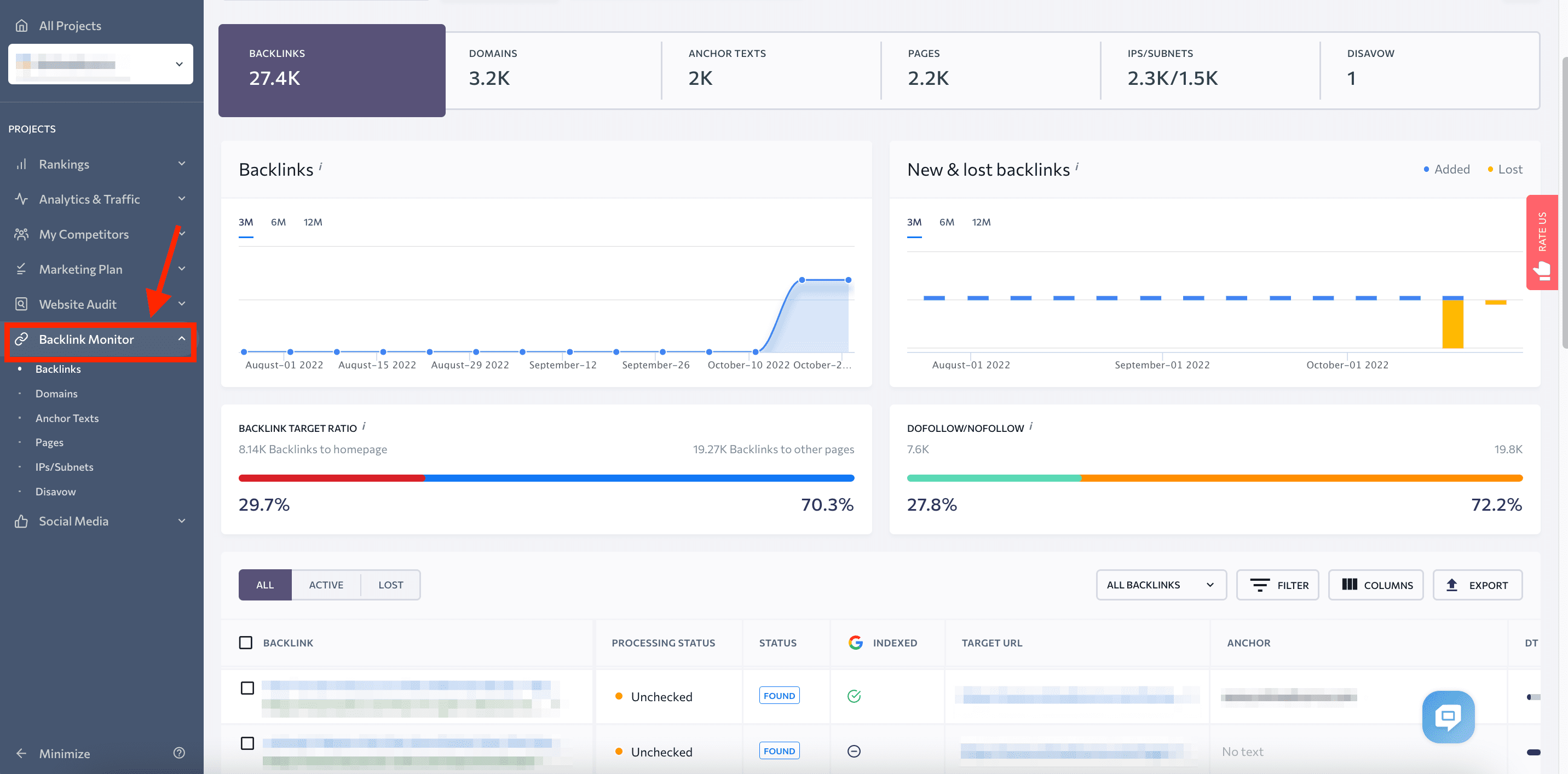
Disavow unwanted links
Not all that glitters is gold, right? Well, the same goes for backlinks. Some of them are better disavowed.
Google Search Console’s help center identifies two cases when you should disavow backlinks:
- You have many spammy, artificial, or low-quality backlinks links.
- The backlinks already caused a manual action on your site, or likely will cause it.
You should only disavow a link when you are 100% sure it’s harmful to your website. Analyze every backlink carefully so you don’t accidentally reject quality links.
Make a list of links you want to disavow
Use SE Ranking’s Backlink Monitoring Tool to mark an unwanted link as Disavow. It will appear in the Disavow tab. Then, export the list of disavowed links, but don’t forget to choose Text file for Google Search Console.
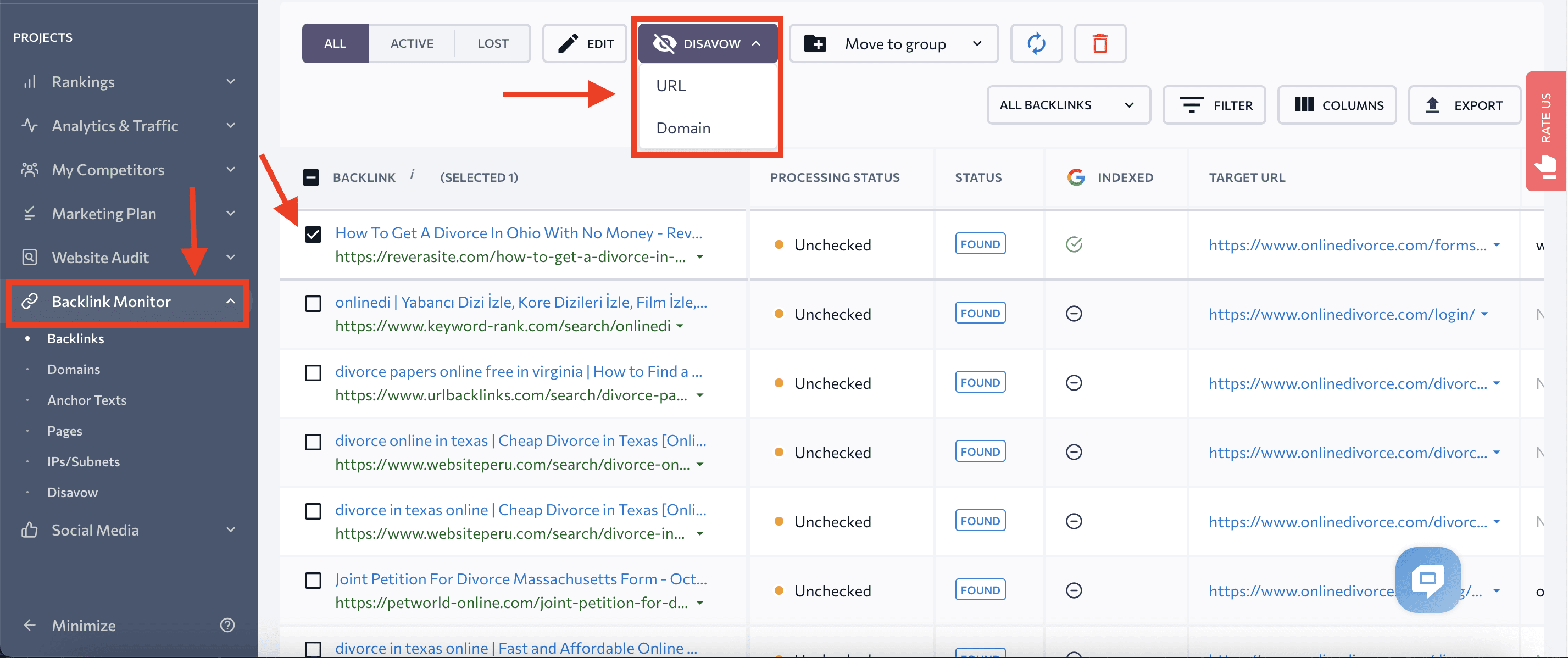
You can also compile the list manually by following these recommendations:
- Add a URL if you want to disavow one backlink in particular.
- If you want to disavow several backlinks, add their URLs one per line.
- Add a domain without a protocol if you want to disavow all backlinks from that domain.
- The file name must end in .txt
# Three pages to disavow http://examplesite.com/webpage http://examplesite.com/webpage http://examplesite.com/webpage
# One domain to disavow domain:examplesite.com
Upload your list to Google disavow links tool
- Go to the disavow links tool.
- Choose a property from the property list.
- Hit the button to upload your list (the new file will replace the already loaded one).
- Select the disavow file from your computer.
A file that doesn’t meet the requirements won’t be uploaded. Correct any errors and try again. After a successful upload, Google may need a few weeks to index your list.
Track rankings
Backlinks are closely related to rankings. You should monitor how the positions of pages change in the SERP for given keywords. Also, analyze whether the backlinks on these pages contribute to their progress or cause drops.
The most convenient way to do this is by using SE Ranking’s Website Rank Tracker. This tool allows you to track positions in real time (in 5 search engines). You can also use it to keep a close watch on your SERP competitors.
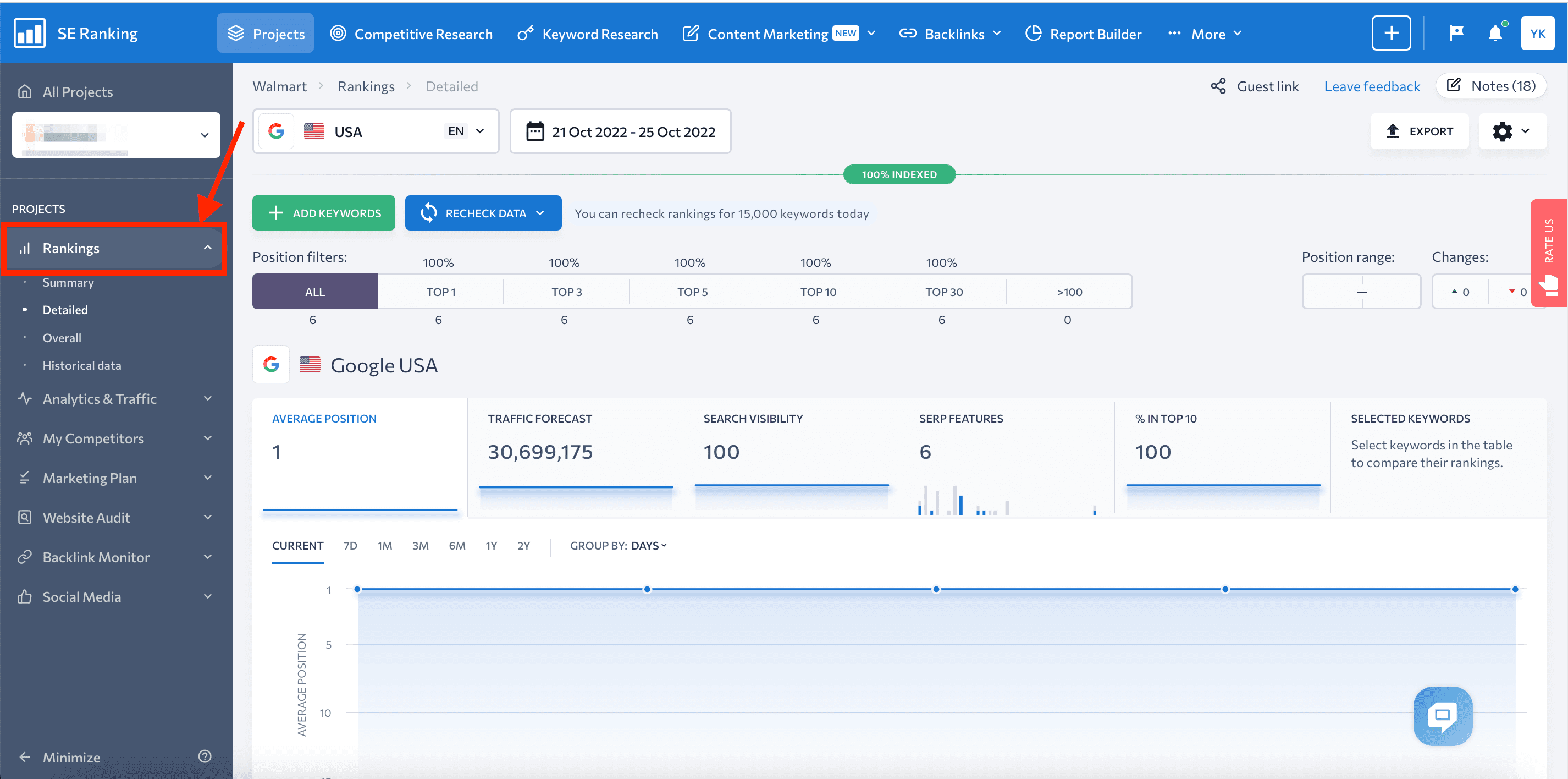
To do this, assign target URLs (with or without backlinks) to your target keywords. Monitor their performance in the SERP and adjust your SEO strategy if the results are poor.
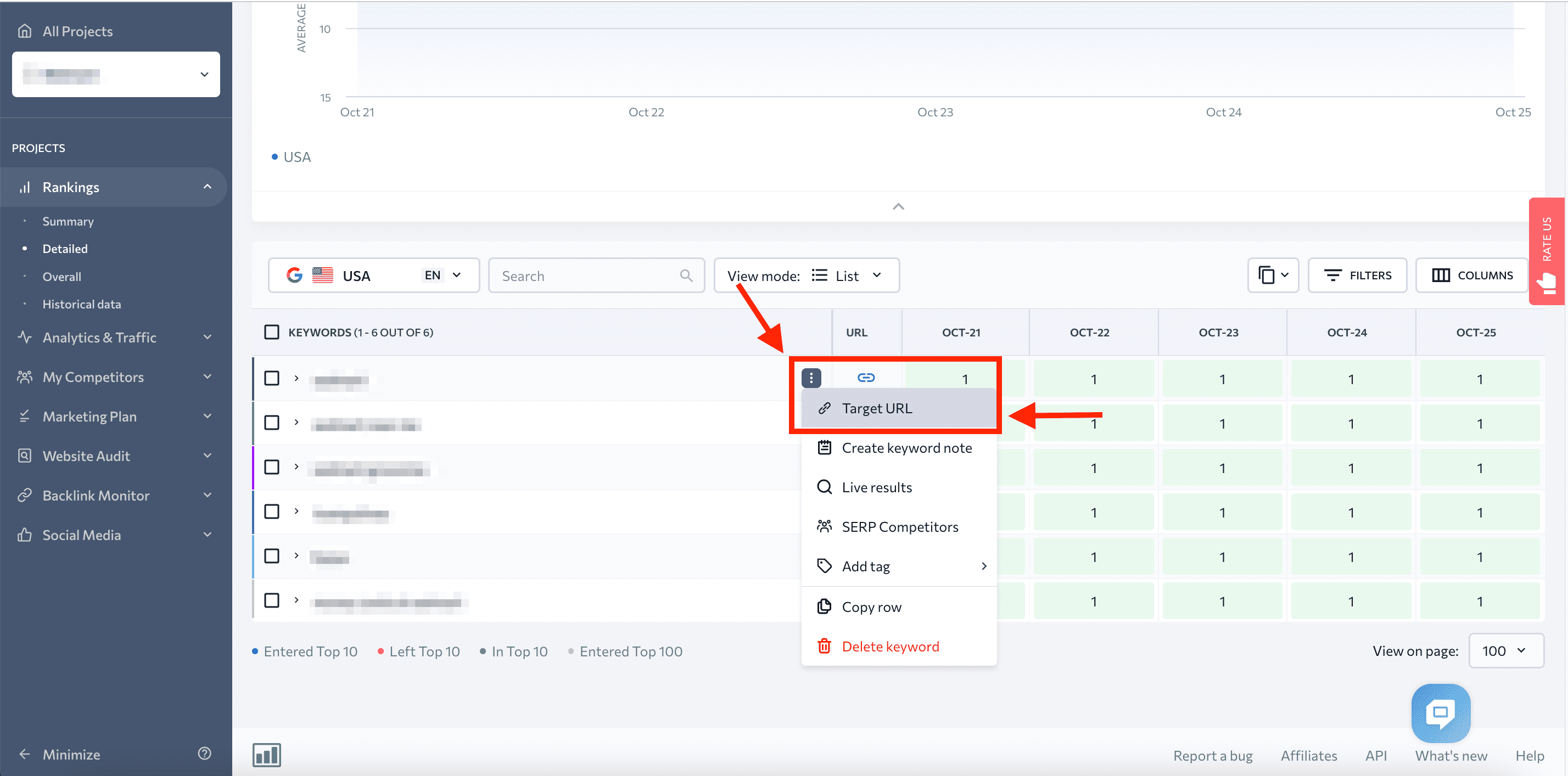
How to earn new backlinks to your website
Earning backlinks is an important part of any effective SEO strategy, but not all backlinks are created equal. Some of them can even hurt your SEO, especially if they come from low-quality or spammy websites. This is why you must prioritize getting high-quality, relevant backlinks to improve your SEO. It will also strengthen your backlink profile and drive more traffic to your site.
Here are some practical ways to earn backlinks:
- Create high-quality content
This is the best way to receive backlinks. People will want to link to your website if you have high-quality and original content in the form of blog posts, infographics, videos, or other informative, helpful, and engaging content.
- Reach out to other websites
Contact other websites in your industry and ask if they would be interested in linking to your content. You can utilize various mediums such as outreach emails or social media platforms. You can also offer to write a guest post with a link back to your website in your author bio or in the content.
- Participate in online communities
You can include a link to your website in your profile or bio, but you must provide valuable insights and information without spamming or engaging in direct self-promotion.
- Create business and online directory listings
When creating a profile, you can include a link to your website in your listing. This approach can also enhance your online visibility and drive more traffic to your website.
Check out our webinar with Farzad Rashidi, Сo-Founder of Respona, on choosing the right websites and strategies for link building.
By using these techniques, you can build high-quality backlinks that will help improve your SEO and grow your online presence over time. With the help of the backlink tools suggested in this article, you’ll be able to keep track of them with ease.
Closing thoughts
Backlink analyses allow you to:
- Evaluate your backlinks’ quality and their health profile.
- Identify links from questionable domains and disavow them.
- Find out what people are saying about your service, product, or brand.
- Spot spam links to your site.
- Analyze competitor backlinks and compare them to yours.
But not all instruments let you assess all of the above features.
Tools from Bing or Google to search for links can be useful if you’re just looking for a bigger-picture perspective. But it isn’t always enough because, as you know, the devil is in the details. For deep analytics and data-driven insights, we advise you to add SE Ranking’s backlink tools to your SEO toolkit.
This way, you can:
- Find every single backlink to your website, even the ones search engines don’t see.
- Run a backlink analysis against key parameters.
- Examine any backlink profile, not only yours.
- Compare backlink profiles and identify backlink opportunities.
And if you’re still not using SE Ranking, take advantage of our free 14-day trial to discover all our SEO features!
